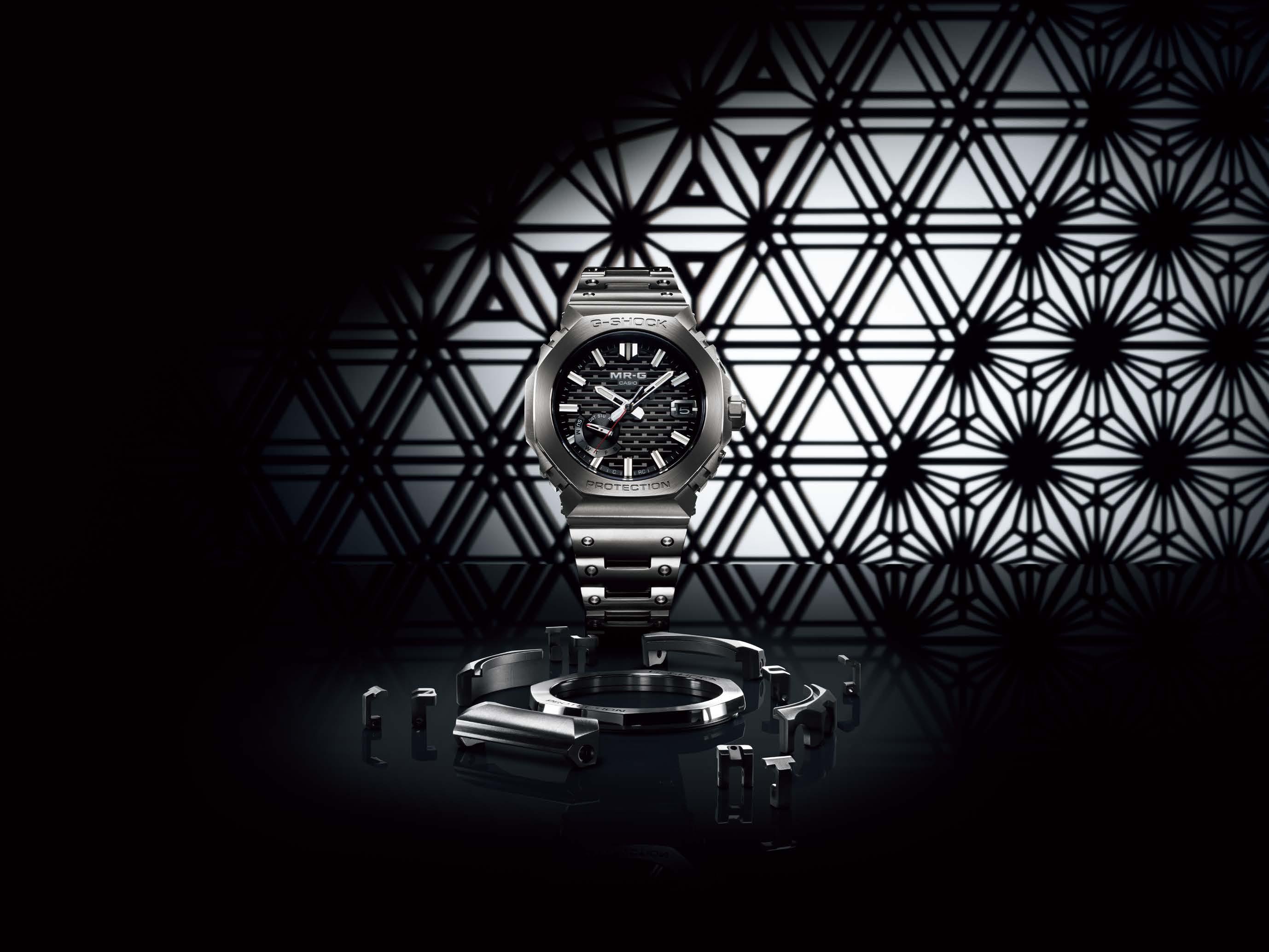














Every new shopping centre in Tokyo these days makes a point of incorporating plenty of plant life on its premises, but Green Terrace Omotesando takes the welcome trend one step further: its entire four-storey structure is designed to look like a giant tree. Architect Takeshi Tsuchiya’s creation includes a lush rooftop lookout with views towards the Meiji Jingu forest, reached by a staircase that circles the building like a vine. On your way up, grab some speciality coffee from Philocoffea (see p15) and a cool treat from Eriko Osawa Earthly Gelato, plus some flowery fragrances from French import L’Artisan Parfumeur. à 3-8-15 Kita-Aoyama, Minato (Omotesando Station).
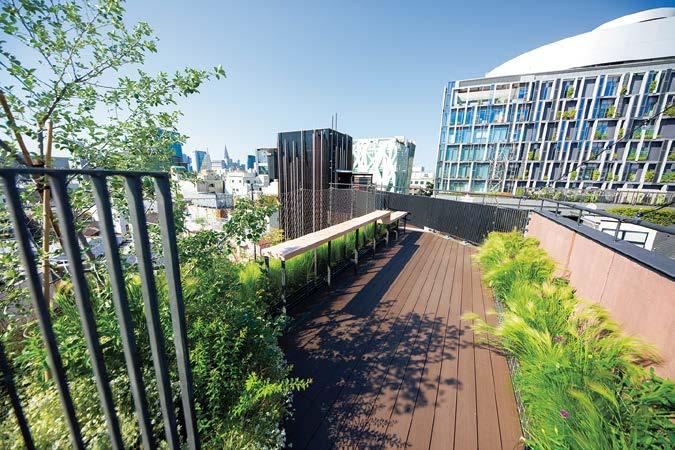
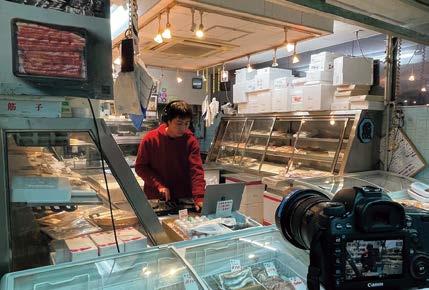

THAT
earlier this
And with airlines around the world adding Tokyo flights to meet Japan’s recordbreaking
– a
of 40.2 million visitors is expected for 2025, up 9 percent from last year – the skies above the capital are sure to get even more crowded.
CHANNELLING THE POWER OF TIGHT TUNES to spotlight endangered sites of urban culture, online music broadcaster Login.jp’s new YouTube session series ‘The Shoten’ brings DJs into everyday Tokyo spaces like traditional coffeeshops, oldschool candy stores and neighbourhood fishmongers, showcasing these community gems along with some of the city’s hottest young selectors. à tinyurl.com/TOTfishshopDJ.
FOOD HALLS FEATURING SOME OF THE CITY’S COOLEST EATERIES have been popping up all over the city lately. At P in Futako-Tamagawa you can feast on Nepali curry at Adi, go for pastries and natural wine at Massif, pair craft beer with a wagyu burger at Mikkeller or bite into NYC-style pie at Pizza Slice Tokyo. For a selection of unadulterated Taiwanese grub, hit up K, D, C in Shin-Okubo. à p.ublic.jp | à kdc-foodlab.com.
With so much to see and do in Tokyo, it can sometimes be hard to figure out how to make the most of your time. Skip the effort of planning your next outing with some of our favourite guided city tours

Metropolitan Area Outer Underground Discharge Channel
Affectionately known as the Disaster Prevention Underground Temple, this massive tunnel up in Saitama is used to prevent flooding in the Greater Tokyo area during a major natural disaster such as a tsunami or typhoon. When not in use, the epic structure is open to the public for guided viewing.
à tinyurl.com/TOTugtempletour. From ¥1,000.
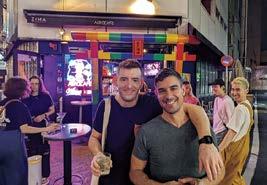
Start by taking in the underground queer culture of Asakusa while your guide provides insightful history of the local sights, then head to Shinjuku Nichome and learn how the area came to be the heart of gay Tokyo. This three-hour affair provides a compact crash course to the capital’s LGBTQ+ scene and can be arranged for groups of up to eight.
à tinyurl.com/TOTlgbtqtour. From ¥12,789.
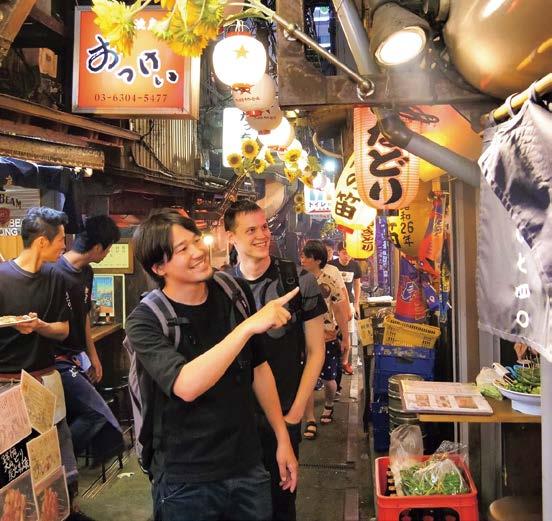
Not sure how to get into the izakaya scene? This three-and-a-half-hour tour through some of Shinjuku’s most bustling bar streets makes a pretty good introduction, with visits
to three watering holes – including an all-you-can-drink spot serving up some dangerously boozecompatible bites.
à tinyurl.com/TOTizakayatour. ¥16,590.

Three fireworks displays you won’t want to miss this summer
Tokyo’s biggest and Japan’s oldest pyrotechnics show dates back to 1733 and attracts close to a million spectators every year (plus at least another two million watching live on TV). A staggering 20,000 fireworks are launched from two sites on the Sumida River around Asakusa Station, all while roughly the same number of security guards do their best to keep the crowds in check.
Taking advantage of a serendipitous schedule clash, Itabashi’s annual spectacular takes place at the same time as the one in the city of Toda (Saitama prefecture), just across the Arakawa River. You can expect a combined 15,000 shells of fireworks at the 90-minute event, including the spectacular ‘Niagara Falls’, a 700-metre chain of explosions that always draws the biggest cheers of the night.
The Chofu fireworks festival by the banks of the Tama River brings much of western Tokyo together to enjoy an early-autumn show featuring a slew of massively colourful explosions synchronised to pop songs using computercontrolled audio and launch systems.
There’s far more to Shibuya than the iconic scramble crossing, Yoyogi Park and the ever-popular Harajuku. Head north from Yoyogi-Uehara and you’ll discover one of our favourite hidden gems in the district: Nishihara. This stylish enclave is a delight to explore, packed with charming bakeries and restaurants, cosy bars and chic lifestyle shops. The area’s bustling shopping street flows seamlessly into neighbouring Hatagaya, another lovely ’hood home to numerous hole-in-thewall eateries, timeworn cafés and hip boutiques. Together, Nishihara and Hatagaya make for the perfect pairing when you’re in the mood for a laid-back yet exciting urban adventure.
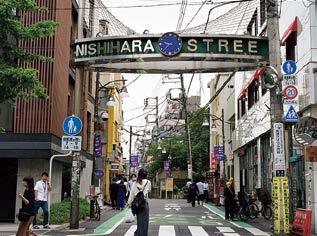
Opened in 2020 by a couple who relocated to Tokyo from Brooklyn, Freeman Shokudo has built up a solid fan base with its excellent barbecue. The laid-back smokehouse doesn’t serve your typical American BBQ fare, showcasing instead a unique style that proprietor Jeremy Freeman perfected over the years at his backyard parties back in Brooklyn. à 2-27-4 Nishihara, Shibuya (Hatagaya Station). 03 6317 7262. instagram.com/freemanshokudo. 12noon-3pm, 6pm-10pm; Sat, Sun & hols 12noon-10pm, closed Mon.

This chic patisserie is helmed by chef Yuichi Goto, who served as pastry chef at the threestarred restaurant Troisgros in France and co-owns the acclaimed Path in nearby Tomigaya. Since opening in 2019, Equal has drawn baked-goods enthusiasts for its refined pastries and sweets. Must-tries include the delicate cheesecake encased in a thin crust and Goto’s signature choux à la crème with light pastry cream.
à 2-26-16 Nishihara, Shibuya (Hatagaya Station). 03 6407 0885. instagram.com/equal_pastryshop. 10am-5pm, closed Mon-Wed.

An institution in the neighbourhood since 2016, Àcôté – ‘next door’ in French – is the perfect way to describe this zakka (variety) shop, as it’s like your friendly neighbourhood shopping spot. You can browse for everything from kitchen tools and Japanese stationery to playful knick-knacks – alongside a wellcurated selection of French natural wines. à 1-7-5 Nishihara, Shibuya (Hatagaya Station). instagram.com/ acote.tokyo. 11am-7pm, closed Sun & Mon. n
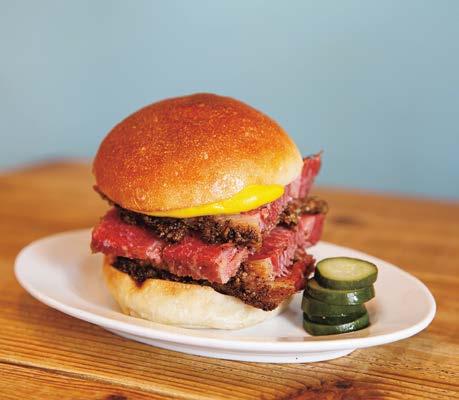
This tiny standing bistro is a local favourite, cherished for its laid-back atmosphere, affable owners, immaculate food and top-notch drink selection. With the owner hailing from Kagoshima, the restaurant proudly highlights ingredients from his home prefecture, offering diners a chance to try Kagoshima potato shochu, regional fish, and pork from a special breed that was once nearly extinct.
à #101, 2-47-1 Hatagaya, Shibuya (Hatagaya Station). 03 6276 1514. instagram.com/kitchen_kanezyo. 4pm-11pm, Sat & Sun 2pm-9pm.

Situated in a former laundromat, Laundry Koffiehuis serves speciality coffee that’s carefully brewed to order. Trained at Onibus Coffee in Nakameguro, the proprietor offers a curated selection of single-origin handdrip brews using beans sourced from across the globe. Check out the store’s used apparel section while enjoying a brew.
à 6-37-10 Honmachi, Shibuya (Hatagaya Station). instagram.com/ laundry_koffiehuis 3pm-10pm, Sat & Sun 10am-9pm, closed Mon-Wed.


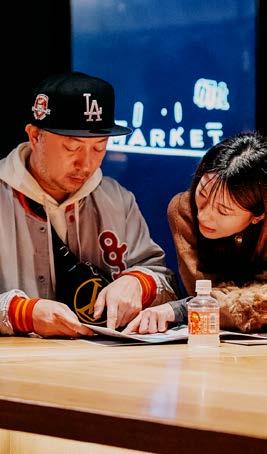








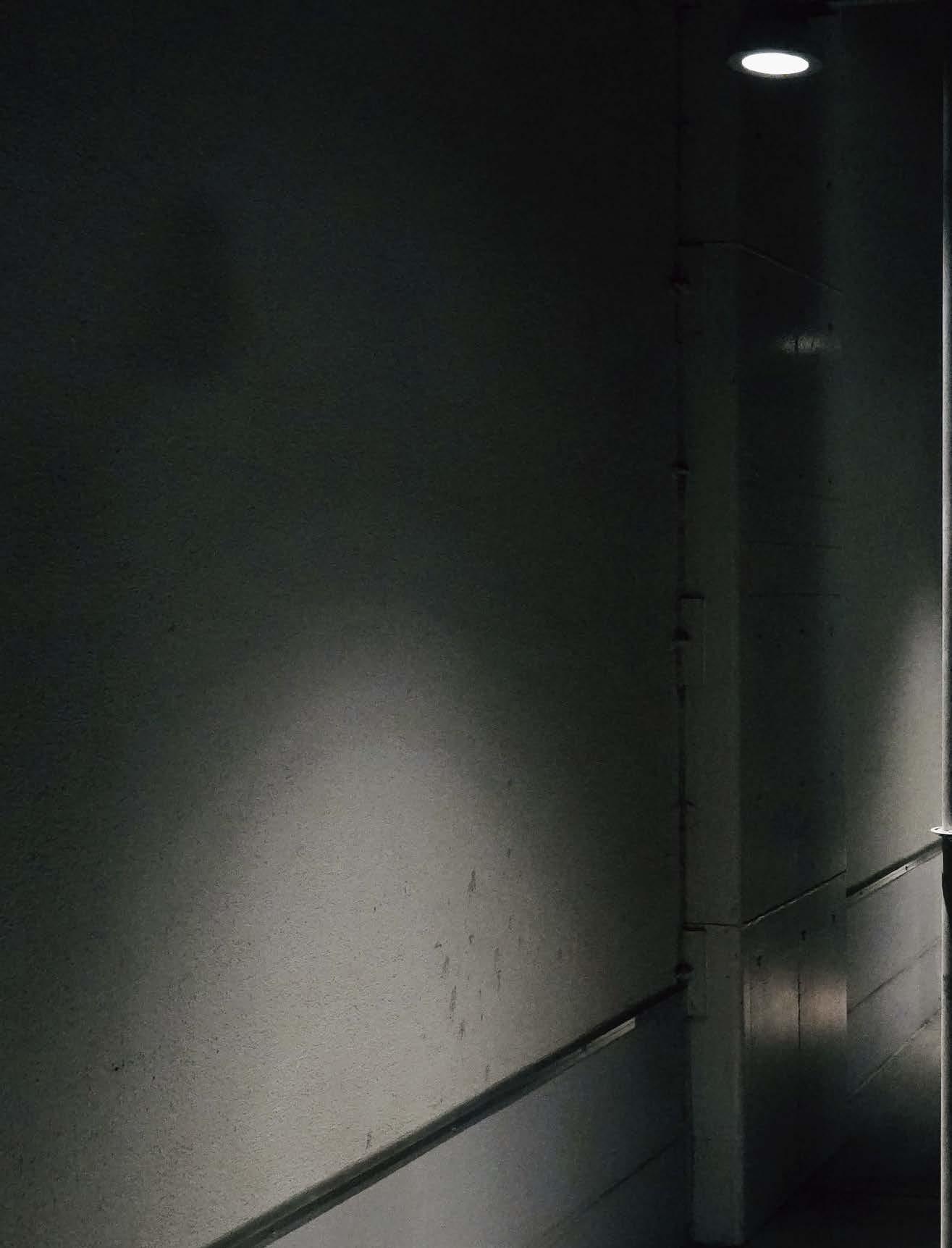


Tokyo never stops. The world’s greatest city pulsates with energy whatever the hour, changing ceaselessly, always offering up something new to discover and relish. To help you make the most of the capital’s relentless abundance, we’ve put in many all-dayers and all-nighters to deliver a round-the-clock guide that puts you right on Tokyo time. On the next few pages, you’ll find all you need to plan an unforgettable 24 hours in the city, from wolfing down a bowl of superfresh seafood before sunrise to embarking on an all-night indie club crawl or soaking in an open-air hot spring at 3am. But before you pound that convenience store energy drink and hit the streets, here’s some choice advice from Orono, our electrifying cover star à

TO GO AROUND THE CLOCK IN TOKYO you need a lot of energy, and Orono clearly has that in abundance. This is a woman who went from rural Saitama to small-town Maine, then London and on to the summit of the global indie pop scene as the lead vocalist of Superorganism, all before her 18th birthday.
Now an accomplished multimedia artist, she’s as kinetic as ever –gearing up to release two new albums, developing a distinctive visual language through her painting, doing a regular show on TBS Radio and much more. Who better then to kick off our guide to Tokyo round the clock?
What are some of your favourite things to do at night? All-nighters at karaoke. Specifically at Manekineko in Nakano, because it’s cheap and you can bring in your own food and drinks. I refuse to pay for karaoke food. Also, I haven’t done this yet, but I’d like to ride one of the boats [down the Sumida River] from Asakusa. I remember sitting on the beach in Odaiba with my friends one night looking at the boats, being like ‘That looks fun, maybe we’ll do that one day when we have more money.’
How do you like life in Tokyo compared to the US and London? I like coming back home. A good and bad thing about Japan is that it’s always the same. This country hasn’t really changed since I was born, which is very comforting. When I’m texting my friends back in the States, they ask me ‘How’s Japan?’ and I’m like ‘Same old, same old, I’m just chilling’. The food is the best here – food, friends and family.
Anything you feel the city needs to do better with when it comes to nightlife?
Less drinking. People drink too much, but that’s also got to do with there not being any other drugs here [smiles]. You don’t want to see people passed out on the streets, so something that would help people drink a little less and be more responsible would be nice.
Tell us about your new band – or are there two?
With cheese touch [Orono’s duo with Mitch Marsico], we’ve been busy playing free shows – because everyone’s broke, including us – and are finishing up an album that’s coming out in August. My other band is called Nose Noise. My dad’s friends and I got together to start it, because my dad’s setting up an indie record label and he wanted me to make the first album for it. That’s coming out early in August, too.
And you’re painting, too?
Yeah, I’m doing a collaboration with [the department store] Isetan, handpainting like a hundred T-shirts. I can’t spend too much time on each one, so I’ll look at the shirt and whatever comes to mind first, I’ll paint. Just vibes, I guess.
Before we reveal our favourite things to do at all hours, what’s your perfect day in the city?
My perfect day would start off with a therapy session. Then I’d go to the Tokyo Gymnasium in Sendagaya and work out for two hours. I’ll do a bunch of machines, run on the treadmill really fast for 30 minutes, then swim for 30 minutes – it’s a whole routine. Then I’d go get food with my friends, head to karaoke together, and then just hang out and drink at a park. n
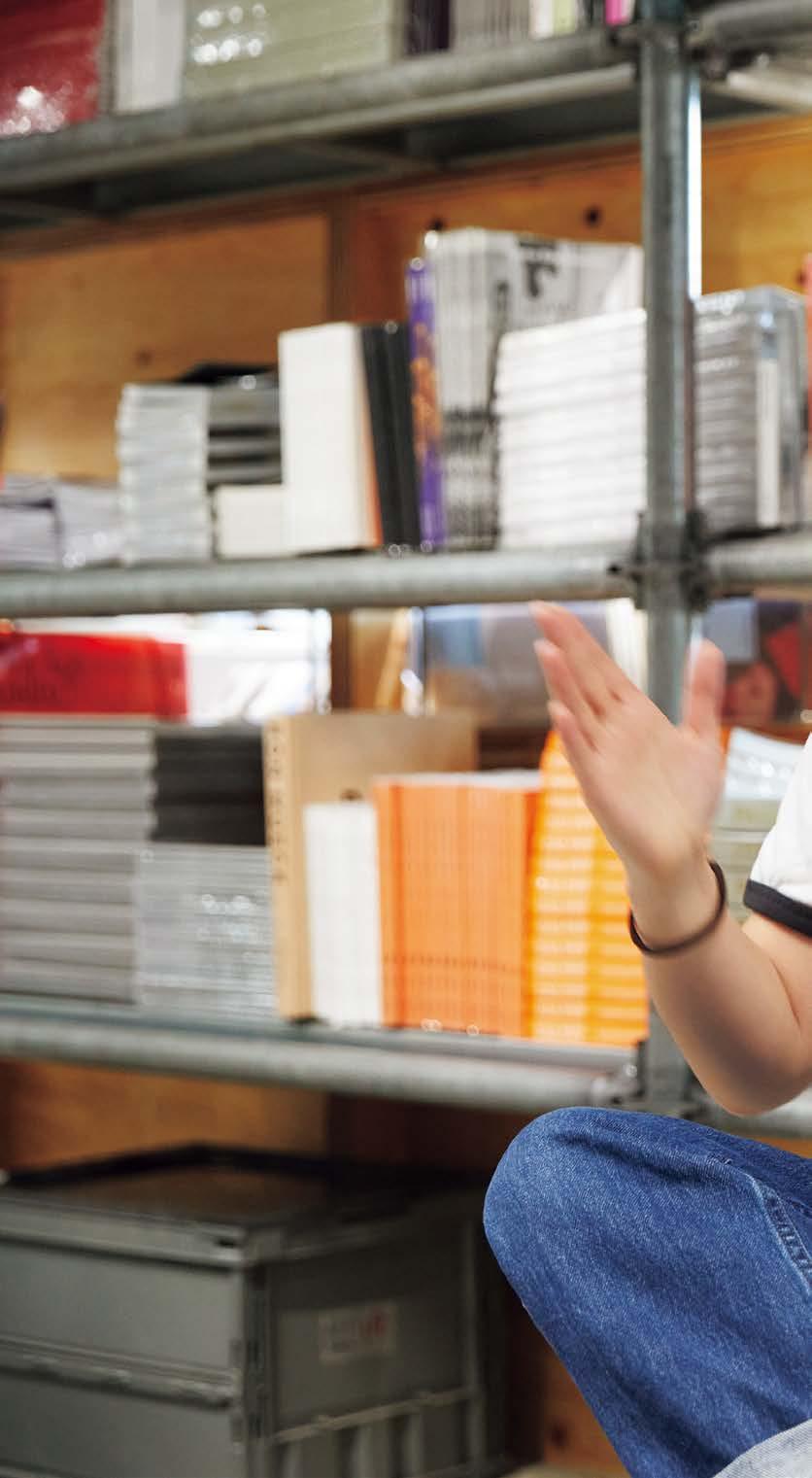

‘I like coming back home… The food is the best here – food, friends and family’


Munching on super-fresh sushi in a fish market at the crack of dawn is an essential Tokyo eating experience. You could undergo the rite at the famous staple Toyosu together with hundreds of jetlagged newcomers… or flee the hungry hordes to Tsukiji, the wholesale market’s former site, where you’ll find equally luscious seafood served in far less sterile surroundings.
Our favourite kaisendon (seafood bowl) at Tsukiji’s outer market comes courtesy of Tsukiji Kanno, a historic seafood-over-rice specialist where the seating options range from a couple of makeshift counters facing the bustling Monzeki-dori street to air-conditioned booths bathed in fluorescent light at the back of the slightly antiquated building. The affable Mrs Kanno’s crew can whip up around 30 different fish and rice combos, among the most notable of which is the everpopular nakaochi tokudon (¥2,200) built around the day’s freshest lean tuna. The morning nigiri sets, meanwhile, start from around ¥2,000.
Not one for fish for breakfast? You might need to wait. Most breakfast joints in Tokyo don’t open until 8am anyway. One of the city’s most reliable purveyors of excellent morning meals is Sawamura, which hails from the Nagano prefecture resort town of Karuizawa but has established a firm hold on the capital’s breakfast scene over the past decade.
Among the company’s half a dozen Tokyo locations, our pick is Bakery Lounge Sawamura Nakameguro. Hidden away on the quieter side of the hip neighbourhood, just a few steps from the Meguro River, the café is worth seeking out purely for its heavenly french toast. This thick slab of Sawamura’s best-selling, ultra-light pain de mie shokupan – caramelised and crispy on the outside, obscenely light and fluffy within – pairs perfectly with a side of artisanal Shinshu bacon from Nagano.
Be sure to lay down a couple of hundred extra yen on a cup of hand-drip speciality coffee; this Sawamura outpost serves as an extension of the brand’s Karuizawa roastery and offers a wide range of singleorigin beans.
Ili Saarinen
à 4-9-5 Tsukiji, Chuo (Tsukiji Station). tsukiji-kanno.com/en. 4.30am-4.30pm (last order 4pm) daily.
à 1-13-6 Aobadai, Meguro (Nakameguro Station). b-sawamura.com/ shop/130. 8am-10.30pm (last order 10pm) daily.
‘The affable Mrs Kanno’s crew can whip up around 30 different fish and rice combos’

Morning pick-me-ups don’t come any more elevated than this. Kickstart your day with a bowl of matcha whisked up fresh 150 metres above the city at Tokyo Tower’s soaring tea ceremony, held in the pointy orange-andwhite landmark’s main observatory on the second and fourth Saturday of the month.
Taking place before the viewing platform is opened to general visitors and admitting only 15-20 participants per ceremony, these sky-high gatherings let you have the tower’s soaring vistas more or less to yourself. Oh, and the tea is pretty tasty too, as you’d expect from a session curated by Soyu Mori, a master of the Urasenke school and a leading teaceremony academic.
Seated on tatami mats (or chairs, in case you’re attending the 9am session) set up by the observatory’s floor-to-ceiling windows, participants are treated to top-grade matcha served in bowls crafted by some of the country’s leading ceramic artisans. But the air of formality ends there: you don’t need prior tea ceremony experience to participate, and staff are happy to answer any questions in English (as well as French and Spanish).
Online reservation required.
Ili Saarinen à ¥3,980. 4-2-8 Shiba Koen, Minato (Kamiyacho, Onarimon, Akabanebashi stations). en.tokyotower.co.jp/plan/tea_ ceremony. From 8am on 2nd and 4th Sat of the month.




A rediscovered love of vinyl by qualityconscious music enthusiasts has made Tokyo’s enviable ecosystem of record stores an object of international wonder and longing. One standout among the city’s countless repositories of analogue treasures is VDS, the Tokyo-born Vinyl Delivery Service’s second physical outpost (the first is on London’s Columbia Road).
Housed in the Skwat Kameari Art Centre, a makeshift collective cultural space hidden under the Joban Line railway tracks that it shares with an architectural office, an art book distributor and a tiny coffee shop, the store doubles as a warehouse for VDS’s online record-retail business – hence the seemingly endless shelves stocked with everything from rock and city pop to reggae and traditional Japanese music. Some of the up to 9,000 records available for perusal are categorised with labels like ‘earth’, ‘fire’, ‘water’ and ‘air’, adding a philosophical touch to the digging experience. Hesitant to pull the trigger on that rare pressing? You’re welcome to play before you purchase – using any of the store’s five different turntables, which are also for sale. Ili Saarinen
à 3-26-4 Nishi-Kameari, Katsushika (Kameari Station). vinyldeliveryservice.com. 11am-7pm, closed Mon, Tue (except hols).


Steer clear of the afternoon slump by descending into the cavelike basement of Green Terrace Omotesando, the flashy fashion street’s newest boutique cluster. This well-ventilated and pleasantly uncrowded refuge is home to Tokyo’s first Philocoffea café, a dainty shrine to serious speciality coffee. Playing the role of head priest here is pour-over phenom Tetsu Kasuya, the 2016 World Brewers Cup Champion, a coffeecommunity celeb famed for his uncompromising approach to both hand-drip science and bean curation. The inventor of the revolutionary 4:6 method – an intuitive formula for dividing the hot water used to brew a cup of coffee, which allows for easy flavour adjustments – Kasuya has introduced the coffee world to a smattering of buzz-generating recipes in recent years. At the Omotesando café he showcases his latest hybrid approach: a combination of pour-over and immersion. The result? An impeccably balanced cup with the silkiest taste around. Alternatively, if you’re on the east side, take your pick of the numerous cafés in Kiyosumi-Shirakawa, Tokyo’s selfproclaimed ‘coffee town’. Then finish with a pit stop at the inimitable Posh, a purveyor of fruit tarts and other lip-smacking vegan sweets liable to set your TikTok on fire. Kaoru Hoshino à B1F, 3-8-15 Kita-Aoyama, Minato (Omotesando Station). philocoffea.com. 10am-7pm daily.
à 1-3-7 Tokiwa, Koto (Kiyosumi-Shirakawa Station). instagram.com/posh.japan. 10am-6pm daily.
Tired of agonising over what to pick off a restaurant menu? Leave the world of endless choice and obsessive customisation behind and embrace the Japanese set meal. Most typically composed of rice, soup and several small sides, the teishoku is a beacon of nutritional balance and rich flavours in an ocean of lopsided servings and ultraprocessed eats.
In its purest form, the traditional teishoku lunch joint – of which there must be thousands across Tokyo – serves only one meal: the daily special. A shining example is Sakura Honten in Iidabashi, where chef Shigeaki Yoshizawa has been conjuring up a different combination of hearty home-cooked dishes almost every weekday for 24 years.
His tastefully decorated restaurant fills up practically as soon as the doors open, and the day’s 50 meals are often all gone within an hour. No wonder: Priced at a barely believable ¥950, Yoshizawa’s teishoku always feature three carefully crafted sides highlighting quality fish, meat and veg, plus a bowl of filling miso soup, pickles, and unlimited servings of rice.
On their way out, many satisfied patrons make a point of eyeing the sign by the door, which lists the content of tomorrow’s teishoku. This is food you could eat every day – and many do. Ili Saarinen
à 1-7-10 Fujimi, Chiyoda (Iidabashi Station). sakura-honten.com. Lunch TueFri 11.15am-1pm (closes as soon as the day’s meals run out), dinner Mon-Fri 5pm-10pm, closed Sat, Sun & hols.
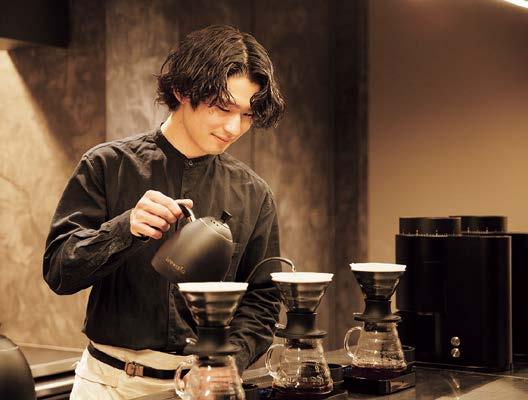

You’re never too far from a park in Tokyo. According to a recent survey by the global digital research platform Freepik, Japan’s capital has more green spaces than any other big city in the world. What’s more, some of these verdant oases hide amazing art and architecture.
Our favourite in-garden gallery is the Tokyo Metropolitan Teien Art Museum, centred on a 1933 art deco mansion on lush, impeccably manicured grounds in Meguro. The house was built by Prince Yasuhiko Asaka, the uncle of Emperor Hirohito, who returned from a three-year stint in 1920s Paris enamoured with art deco.
The prince hired luminaries such as Henri Rapin and René Lalique to design the opulent interior, which has been beautifully preserved over the years. Take in the building’s decorative splendour and illustrious history at the museum’s annual ‘Looking at Architecture’ exhibition (held until August 24 this year), then find a spot to relax in the afternoon shade outside.
You’ll find two other botanically biased museums worth a look in posh Minami Aoyama. The Taro Okamoto Memorial Museum –the avant-garde visionary’s former studio and home – boasts a tiny jungle of a front garden and a frozen-in-time gallery replete with paint splatters and half-finished works, all left untouched since the artist’s death in 1996.
Its polar opposite on the unruliness scale, the Nezu Museum nearby combines a sleek Kengo Kuma-designed building with a private garden where winding stepping-stone paths transport you into Zen-like silence in the heart of the city. Ili Saarinen à 5-21-9 Shirokanedai, Minato (Meguro, Shirokanedai stations). teien-art-museum.ne.jp/ en. 10am-6pm, closed Mon (open hols, then closed the following day).
à 6-1-19 Minami-Aoyama, Minato (Omotesando Station). taro-okamoto.or.jp/en. 10am-6pm, closed Tue (except hols).
à 6-5-1 Minami-Aoyama, Minato (Omotesando Station). nezu-muse.or.jp/en. 10am-5pm, closed Mon (open hols, then closed the following day).
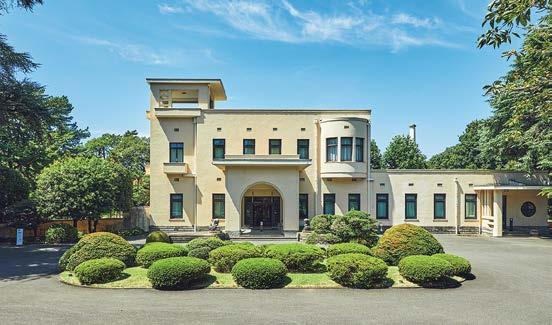
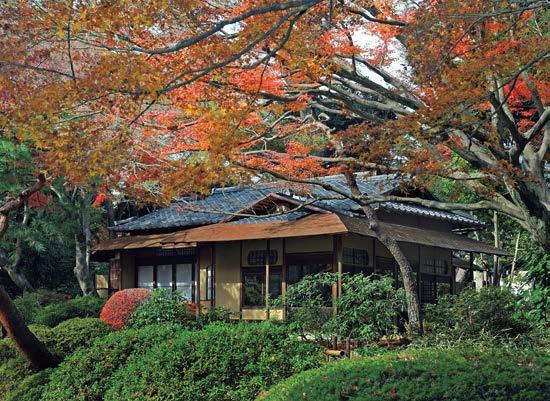

Take your evenings to new heights at Two Rooms, one of Tokyo’s most beloved rooftop destinations. Perched above the stylish streets of Aoyama, this city institution has recently undergone a bold transformation – reimagining the 16-year-old favourite into one of the capital’s sleekest spots for after-dark revelry. Some things haven’t changed – the expansive terrace with its spectacular skyline views is still front and centre – but the original Two Rooms team, ECN Hospitality, have reenergised the venue with fresh interiors, a revitalised food and drinks menu and a dynamic entertainment lineup. Here’s why Two Rooms is more stylish, more delicious and more electric than ever.
The look
When it first opened in 2009, Two Rooms turned heads with its elegant, modernist design. Its next
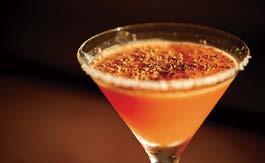

chapter, imagined once again by San Francisco’s Eight Inc, retains that architectural sophistication while introducing a more refined, contemporary edge.

The main space, Atelier 246, features a calming palette of soft greys and greens, designed to let the views through the floor-to-ceiling windows do the speaking. While the more intimate Vista Lounge leans into moodier browns and charcoal greys, offering a seductive vantage point over
the terrace and Tokyo’s glittering skyline.
From mellow sunset sessions to high-energy late-night parties, Two Rooms has mastered the mood shift. With live bands on Fridays and a cast of DJs spinning Thursday to Saturday, the eclectic soundtrack is always on point. Whether you’re after an easygoing evening or a full-throttle night of partying, this rooftop retreat delivers. It’s a magnet for Tokyo’s stylish set: perfect for
private events, impromptu parties and unforgettable nights out.
The food and drinks
The new menu combines premium Japanese ingredients with global finesse: think A5-grade Yamagata wagyu, pristine seafood on ice and freshly shucked oysters. Don’t skip the signature nori wraps – delicate, flavour-packed parcels of wagyu tartare and uni or tuna and caviar. Designed for both indulgent dinners and spirited soirées, the menu pairs beautifully with the venue’s award-winning wine selection, curated sake list and inventive cocktails. Pro tip: start with one of the meticulously crafted martinis and see where the night takes you.
à AO Bldg 5F, 3-11-7 Kita-Aoyama, Minato (Omotesando Station). tworooms.jp/en. 03 3498 0002. Mon, Tue 11.30am-2am, Wed-Sat 11.30am-3am, Sun & hols 11.30am-12midnight.

The nori wraps are a standout
à For more information, check out the website at tworooms.jp/en
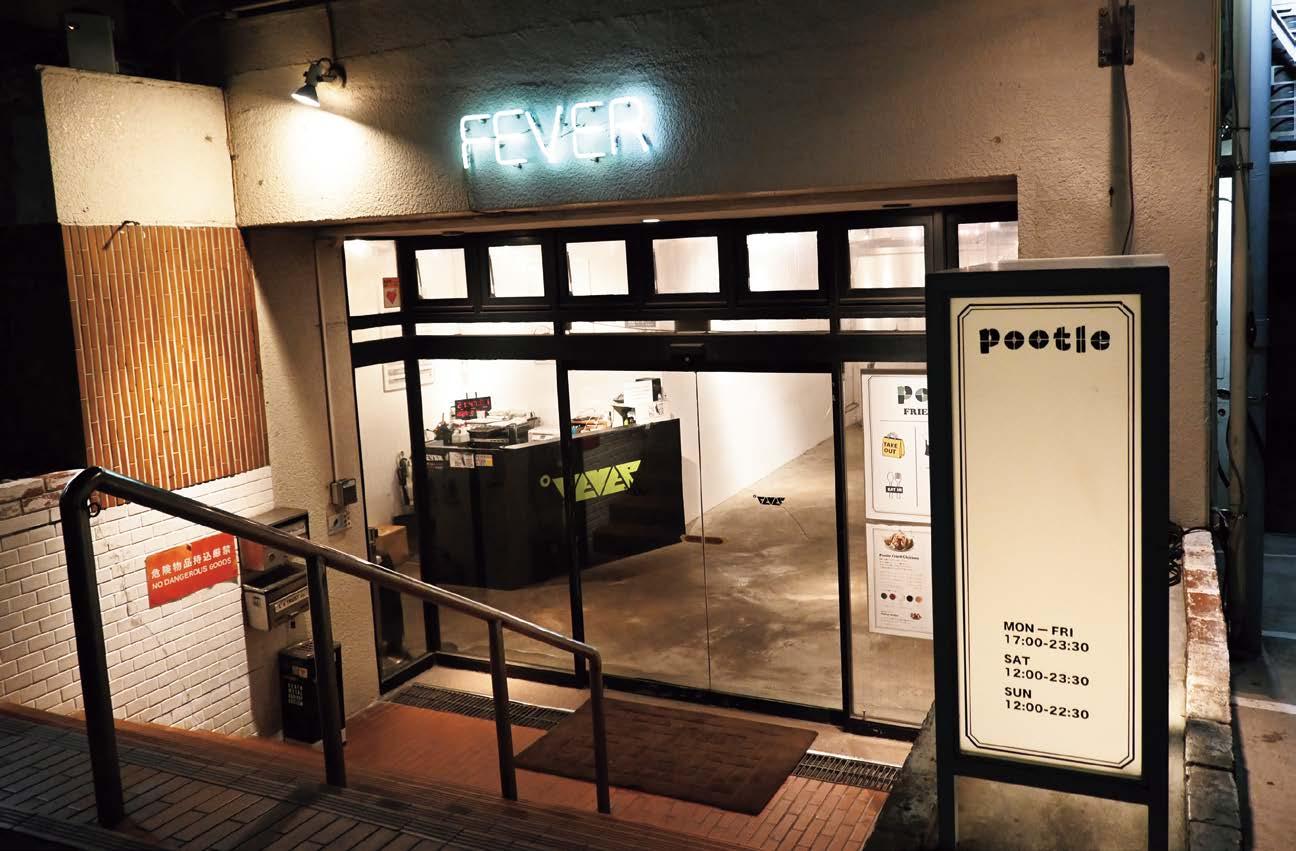



Sprawling, diverse and incredibly interconnected, Tokyo’s music scene rewards intrepid musos with an endless stream of mindblowing tunes you’d have a hard time coming across on Spotify. It’s also fairly easy to explore even if you aren’t a night owl, with gigs typically starting way earlier than at many clubs in the West.
Dive right into the deep end at Fever, the go-to venue for Tokyo’s rising indie acts since 2009. Tucked beneath a swim school just across the street from Shindaita Station, it feels more like a collective art space than a conventional club. The space opens into a roomy entrance hall that connects to Pootle, a Vietnamese-inspired fried chicken joint which doubles as a café and gallery.
The venue itself is a 300-capacity black box – maybe 350 if you really pack it in. With a low stage and a slightly sloped floor, the room offers a solid view of the performance from just about anywhere. Alongside up and comers, Fever has also hosted bigger Japanese names like toe and Galileo Galilei, alongside well-known international acts like Foxing, MJ Lenderman and many more.
Fever keeps things eclectic with a no-genre booking policy, so there’s truly something for everyone. And don’t skip the bar in the main room – it’s stocked with dangerously cheap drinks and American chips like Lays and Fritos.
When the music ends for the night, shuffle over to Candle Cafe in nearby Shimokitazawa to debate drum solos and guitar riffs over a craft beer or strong gin cocktail in the intoxicating glow of handmade candles. George Matsuo
à 1-1-14 Hanegi, Setagaya (Shindaita Station). fever-popo.com/english. See website for details. à 2A, 2-37-9 Kitazawa, Setagaya (Shimokitazawa Station). instagram.com/candlecafe12. 11am-5am daily.
While most of Tokyo’s coolest bars are underground ones – both literally and figuratively – sometimes you want to drink up high. And with the capital’s insatiable appetite for upward expansion, the variety of drinking destinations offering incredible views to go along with a carefully crafted cocktail or cup of fine sake is pretty remarkable. If you only have time for one sky-high boozer, make it the out-of-sight Bulgari Bar. Part of the Italian jewellery house’s very own Tokyo hotel, this semi-alfresco rooftop stunner is perched on the 45th floor of the Midtown Yaesu skyscraper and boasts gemstone-grade cocktails and mocktails to go with the billion-yen vista directly westward. Tip: arrive between 6 and 7pm to marvel at the sunset – and enjoy a complimentary platter of fancy bar bites. Found at a lower altitude, but still lofty in its own way, The Roof at the Tokyo Edition, Ginza hotel is another standout, offering intimate seating surrounded by lush greenery. Opt for one of the seasonal cocktails like the refreshing Ume & Shiso, which blends coconut yoghurt with sparkling sake. If your vibe is more vintage anime T-shirt than designer dress, seek out A-Bridge in Sangenjaya and stick around for a gig or DJ set. Ili Saarinen à Bulgari Hotel Tokyo 45F, 2-2-1 Yaesu, Chuo (Tokyo Station). bulgarihotels.com/ en_US/tokyo/dining/the-bulgari-bar. 12noon-12midnight daily.
à The Tokyo Edition, Ginza 15F, 2-8-13 Ginza, Chuo (Ginza-Itchome Station). editionhotels.com/tokyo-ginza/restaurants-and-bars/the-roof. 5pm-11pm daily (weather permitting).
à Sangen Bldg rooftop, 2-14-12 Sangenjaya, Setagaya (Sangenjaya Station). a-bridge.jp. 12noon-12midnight, closed Wed.

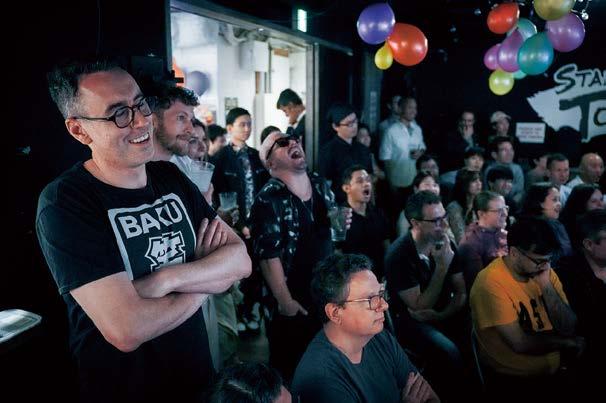
A 90-second walk – trust us, we’ve timed it – from the sensory overload of the Scramble Crossing takes you to an equally gasp-inducing but much more jovial capital institution. Founded and run by comedians, Tokyo’s first (and only) stand-up comedy club puts on shows pretty much every night of the week.
Tokyo Comedy Bar is more than just a stage and seats – it’s a community hub open to everyone partial to laughter and eager to peek into the many hilarious aspects of life in Japan. Expect high-energy performances in both English and Japanese, the occasional big-name headliner from overseas, and a rotating selection of six types of craft beer on tap.
Their flagship Stand-Up Comedy Showcase entertains punters from 7.30pm daily, while the 9pm slot is dedicated to a mix of open mics, international visitors, and monthly affairs like the Gay Agenda, a queer-friendly comedy showcase, and LoLs in Translation, a show about learning Japanese. The venue will play host to the Tokyo International Comedy Festival from September 11 to 21, and TCB is also the force behind the Shinjuku Stage shows, held at Kabukicho’s DecaBar Super every Friday and Saturday night from 8pm. Ili Saarinen
à 1-5-9 Dogenzaka, Shibuya (Shibuya Station). tokyocomedybar.com. Mon-Fri 6.30pm-11.30pm, Sat 6pm-11.30pm, Sun 5pm-11.30pm.

Sweat it out in a next-level
While Nordic sauna culture still has some way to go before it dethrones hot-spring bathing as Japan’s favourite form of wet and sweaty relaxation, the country’s sauna boom is still gaining, um, steam. The trend was to a large degree sparked by Sado (The Way of Sauna), a manga and essay series by Katsuki Tanaka, who has in recent years poured his energy into building the kind of sauna he once only wrote about.
Located just three minutes from JR Shibuya Station, Shibuya Saunas is the culmination of Tanaka’s vision: a modern temple of sweat that’s both
serious about tradition and playful in execution. Guests can choose from nine distinctive sauna rooms, each designed with a different theme – from the silent, pitch-black ‘Musta’ sauna to the musicinfused ‘Sound’ sauna and the serene, tea-inspired ‘Teetä’ room.
The facility’s layout is divided between two areas – Woods and Lämpi – which alternate between men and women on different days, ensuring everyone gets the full experience. Shibuya Saunas is also tattoo friendly, a rare and welcome policy in Japan’s public bath scene, making it a magnet for Tokyo’s creative crowd.
Beyond the steam, Shibuya Saunas offers a plantbased menu crafted by Michelin-starred chef Yusuke Nomura of Shojin Ryori Daigo, plus plenty of lounge space for cooling down. It’s wellness with a pulse; equal parts detox and downtown hangout.
George Matsuo
à 18-9 Sakuragaokacho, Shibuya (Shibuya Station). saunas-saunas.com.
8am-12midnight daily. Mon-Fri ¥3,200; Sat, Sun & hols ¥3,900. Prices are for 2.5 hours for men and 3.5 hours for women.
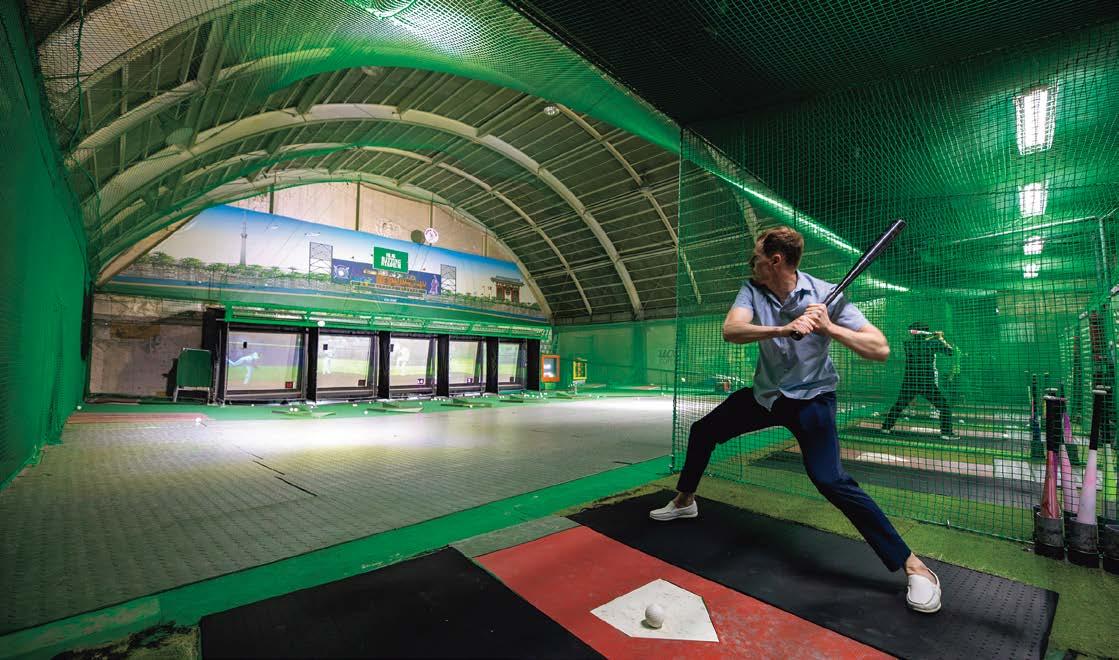

Nothing beats smacking some balls around after a long day. Automated batting cages may no longer be as ubiquitous as they once were in Tokyo – blame baseball’s dwindling popularity – but the ones that remain still make for a fun way to blow off steam.
Our go-to is the first-timer friendly Asakusa Batting Stadium, tucked away on the second floor of a time-worn gaming arcade near Sensoji Temple and instantly recognisable by the giant glove above the entrance.
The clientele is diverse, ranging from complete rookies to former high school heroes capable of regularly hitting 150km/h pitches – the fastest setting here – deep into the (virtual) stands. Pitches are synchronised to videos of hurlers from Japan’s pro league, making you feel like you’re going up against a real opponent. One game of 20 balls costs ¥400, and the Stadium even has a bullpen with a pitching skills simulator for those that want to test their arm.
The only drawback is the all-too-early 11pm closing time. Those who’d like to keep swinging into the wee hours will want to seek out the Shinjuku Batting Centre in Kabukicho, where the floodlights stay on until 4am, or the nearby Oslo Batting Centre, an equally unembellished establishment where the tireless mechanical arms keep working until 1am.
Ili Saarinen
à Rox Dome 2F, 1-27-5 Asakusa, Taito (Tawaramachi Station). asakusa-bs.com. 10.30am-11pm daily.


















While Tokyo has its fair share of mega-clubs, what really sets the capital’s all-night music scene apart is the profusion of modestly sized but wildly ambitious venues. Call them underground, left-field or experimental, the best of these spots blend creative programming and meticulously tuned sound systems with a lively community-first spirit. Start a night of immersion into the local scene at Hven, a brushed-metal hideaway beneath the train tracks in Nakameguro that feels both futuristic and grounded, intimate and expansive. The entrance alone, a long corridor running alongside the railway, sets the tone: You’re stepping out of the city and into something else entirely. Inside, things centre on a compact dance floor and a powerful sound system pumping out house, techno or the occasional hip hop set. But most people end up flowing between the rooms – chilling in the lounge where the music still plays but at a less intense volume, or drifting out to the smoking patio under the night sky. Hven isn’t just a music bar; it’s a platform for crossover culture. Besides great music, expect contemporary art, eclectic live performances and experimental showcases. Next, move up to Enter in Shibuya, a 150-capacity club with an airtight sound system. Here the DJ booth is planted right in the middle of the dance floor, dissolving the usual distance between performer and crowd and creating a truly immersive, all-around-you experience. Each corner of the room is fitted with high-end speakers and a Meyer Sound subwoofer, making the space feel less like a club and more like a finely tuned instrument – built for those who really want to listen, not just be seen. Still want to keep the party going? Head to Aoyama Hachi – a strong candidate for the smallest four-storey club in the world, and an ever-reliable sanctuary for cutting-edge sounds. George Matsuo
à 1-6-10 Kamimeguro, Meguro (Nakameguro Station). instagram.com/hven.tokyo. 11am-9pm, 10pm-5am daily.
à Gems Jingumae 6F, 6-19-17 Jingumae, Shibuya (Shibuya Station). entershibuya.com. Hours vary by event.
à Aoyama Bldg 2F-4F, 4-5-9 Shibuya, Shibuya (Shibuya Station). aoyama-hachi.net. Hours vary by event.
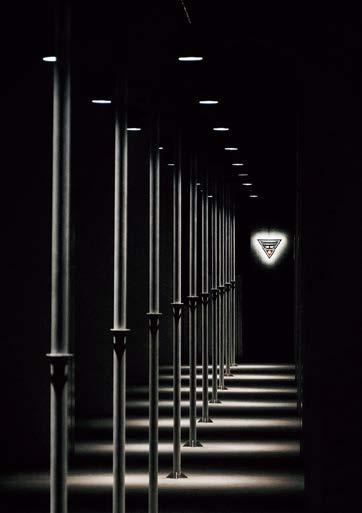
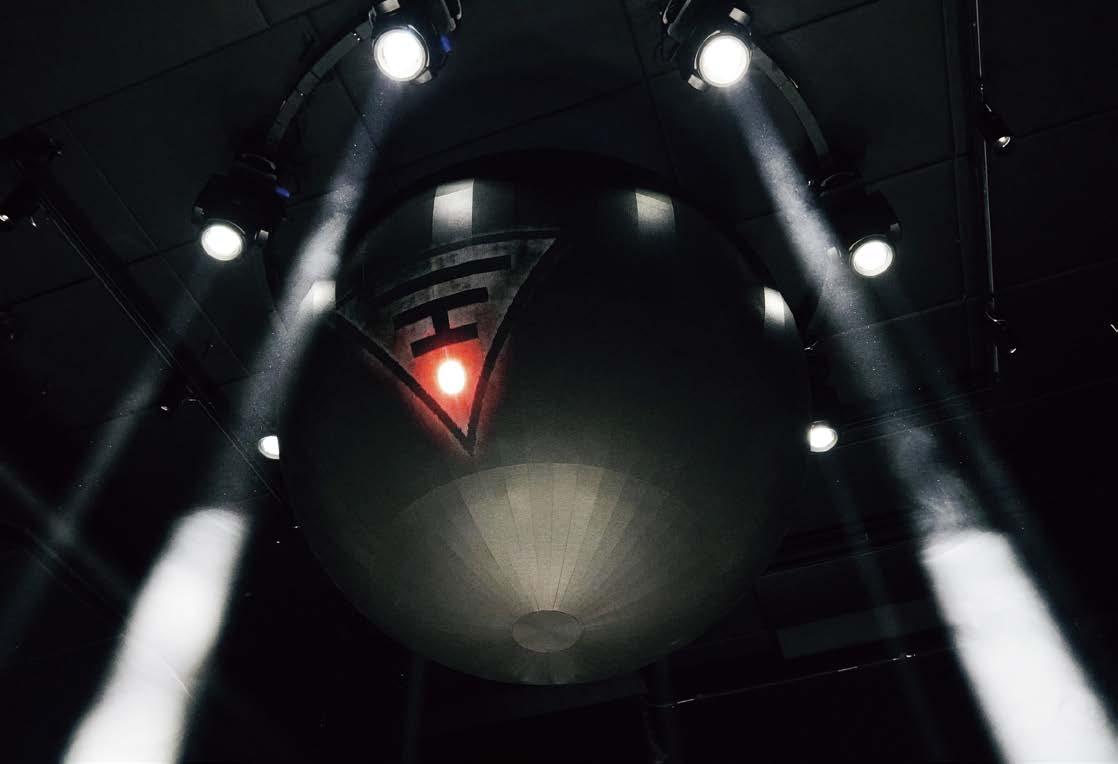




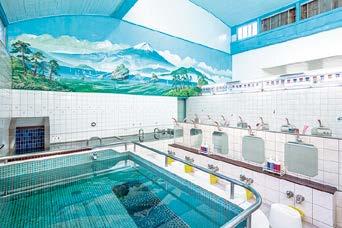
Communal sento bathhouses may be foreign to most tourists, but they’ve been an inextricable part of life in Tokyo for centuries. While no longer an essential element of the city’s infrastructure – most Tokyoites are now content to bathe and shower at home – sento have been undergoing a renaissance of sorts in recent years. Some bathhouses have reinvented themselves with sleek interiors, others by opening a pub or eatery on their premises. Yet others, like Daikoku-yu right beneath Tokyo Skytree, have decided to take things back to basics.
A shining example of the old-school neighbourhood communal bathhouse, Daikoku-yu stays open through the night and fills its tubs with natural hot spring water pumped up from deep under the city. The star of the show is the spacious rotenburo open-air bath, where you can soak while gazing at Tokyo’s tallest structure and taking in the faint nocturnal sounds of the city. Ili Saarinen à 3-12-14 Yokokawa, Sumida (Oshiage Station). daikokuyu.com. Mon, Wed-Fri 3pm-10am (next day), Sat 2pm-10am (next day), Sun and hols 1pm-10am (next day), closed Tue. ¥550.

Forget pizzas, kebabs or even tacos – nothing tastes better after a long night out than a hot and greasy serving of noodles. And in the ramen capital of the world, there’s a plethora of amazing bowls to choose from at any hour. Our go-to purveyor of invigorating late-night cholesterol bombs is Akanoren. A stumbling distance from Roppongi, it has been serving up Hakata-style tonkotsu ramen – thin, flat noodles in a light, pork-based and soy-sauce flavoured soup – by the Nishi-Azabu crossing for well over four decades. Tip: Be sure to get a plate of bitesized sui gyoza (boiled) dumplings to go with your bowl. Stop by the ATM on the way – this place is cash only.
In Shinjuku, set course for Sugoi Niboshi Ramen Nagi, and brace for the smell – the speciality here is pungent niboshi ramen, made by boiling vast amounts of dried sardines for 12 hours to create a distinctive, boldly flavoured soup that’ll blow away any lingering drowsiness. In Ginza, Shinamen Hashigo does a range of manageably spicy dan dan noodles with meaty toppings, while Kamo to Negi in Ueno specialises in duck noodles with a beautifully clear stock that’s light yet flavourful. Menchuck
à 3-21-24 Nishi-Azabu, Minato (Roppongi Station). akanoren.com/shop#a01. 11am-5am, closed Sun.
à 2F, Shinjuku Golden Gai (G2 Street), 1-1-10 Kabukicho, Shinjuku (Shinjuku Station). n-nagi.com/english. 24 hours daily.
à 6-3-5 Ginza, Chuo (Ginza Station). 11am-5am (Sat, Sun & hols until 9pm).
à 6-4-15 Ueno, Taito (Okachimachi Station). kamotonegi.com. 24 hours daily.

Cap off your round-the-clock adventure by taking in the awe-inspiring sight of the sun emerging from the calm expanse of Tokyo Bay. While there are plenty of places along the waterfront offering unimpeded views towards the east, not all of these are easy to reach or possible to enter before the rest of the city wakes up. Here are three Tokyo sunrise spots you can visit at any hour and won’t need to scale any fences to get to.
To position yourself for one of Tokyo’s coolest sunrise views, walk through Shibaura in the early-morning haze

to find a spot just west of the Shibaura Loop Bridge, on the western end of the Rainbow Bridge. From here, you can watch the mammoth structure transform into a gigantic diamond ring, with the sun itself bringing the bling as it emerges above the farther end of the circle.
The Terminal 3 Observation Deck at Haneda Airport stays open 24 hours and offers the dramatic vista of parked planes illuminated by the day’s first orange rays. Hop on the morning’s first monorail from Hamamatsucho Station at 4.59am and you’ll be at Terminal 3 around 5.12am –early enough for the sunrise at any time of year except July and the first half of August.
Alternatively, swing like you’re winning in Wakasu Seaside Park at the foot of the Tokyo Gate Bridge, where a strategically placed piece of playground equipment adds a fun element to one of the city’s most majestic sunrise views. Note: this spot is really far out, so you might want to rent a bike or e-scooter for the trip. Kensuke Yamaguchi n

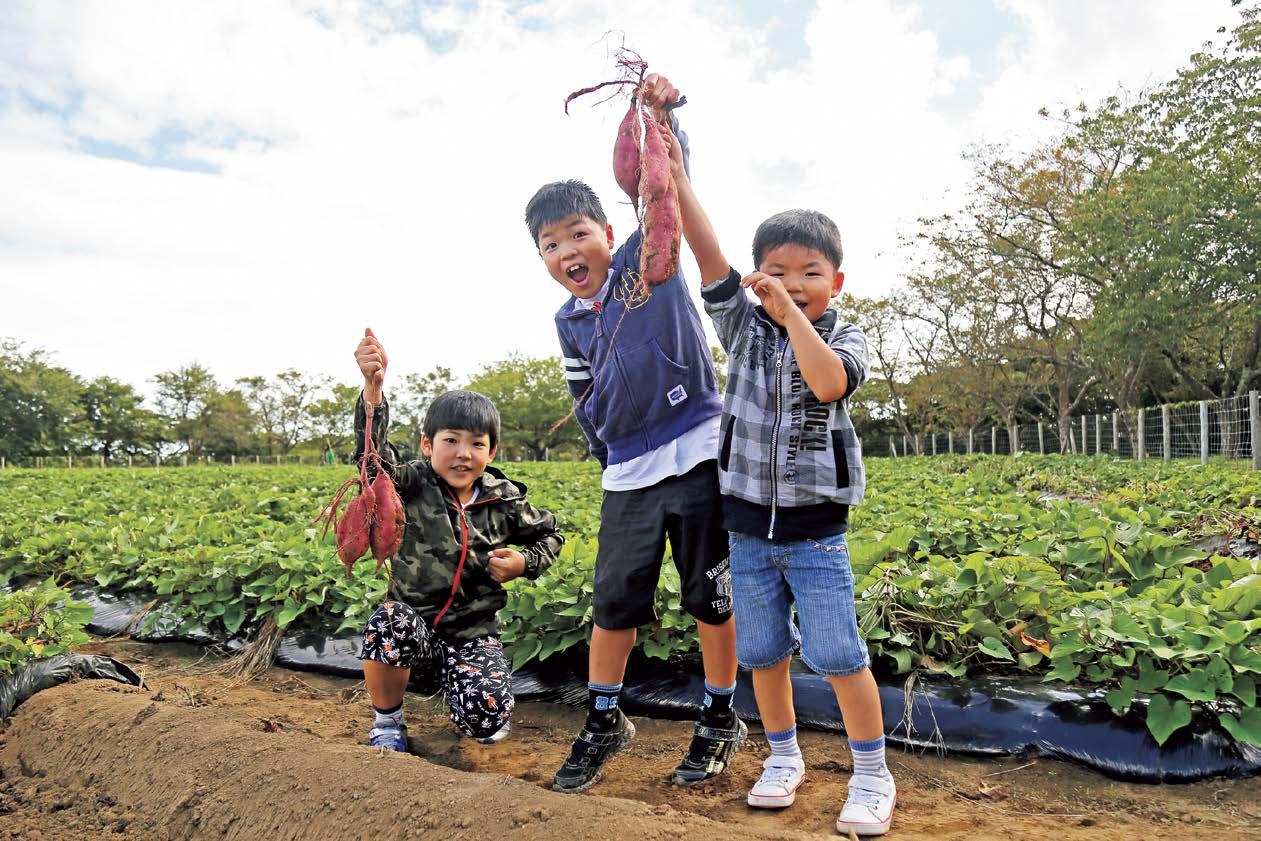
Spend a day amid nature picking fresh fruit and veg at these green escapes in and around Tokyo. By Shota Nagao
FRUIT PICKING AND VEGETABLE HARVESTING EXPERIENCES are available outside the city year-round, but are an especially alluring escape from sweltering central Tokyo in the summer. We’ve rounded up the best family-friendly farms for crop picking – all within easy reach of the city.

Yamauchi Vineyard
BEST FOR: GREENS
Despite its name, Yamauchi Vineyard in Chofu grows much more than just grapes. This family-run farm offers seasonal picking throughout the year, with over 80 varieties of produce cultivated on-site. Standouts include kaki persimmons, strawberries, sweet potatoes, bamboo shoots and carrots.
While many of the farm’s activities are tailored to children, such as traditional mochi-pounding, adults will also enjoy the experience of hand-picking fresh vegetables – some unique to Japan, like satsumaimo sweet potato – to take home and cook. Reservations are required via the Aini booking platform (in Japanese only) and a basic understanding of the language is recommended for participation.
à 3-28-7 Wakabacho, Chofu (Sengawa Station, Irimacho-Itchome bus stop). instagram.com/ yamauchi.kaju. 10am-1.30pm daily.
BEST FOR: BERRIES AND BUNGEE
Located in the rolling hills of Chiba prefecture, Mother Farm is perfect for a family adventure. While it’s best known for its adorable animals and seasonal flower fields, the farm also offers picking experiences that change throughout the year, including blueberries in summer, kiwi fruit in autumn and strawberries in winter and spring.
The farm’s appeal lies in its variety: after harvesting some fruit, you can watch a sheepdog show, try bungee jumping (Sat & Sun only) or snack on freshly made dairy treats like milk ramen. You’ll also be able to spend a fancy night at the farm in one of its glamping tents. Easily accessible by car or shuttle bus from Kimitsu Station, it is an ideal rural getaway.
à 940-3 Tagura, Futtsu, Chiba (paid shuttle bus service from Kimitsu Station). 0439 37 3211. motherfarm.co.jp. Mon-Fri 9.30am-4.30pm, Sat, Sun & hols 9am-5pm, closed Dec 15-19. KISA

Tsukuihama Tourist Farm
BEST FOR: SWEET SPUDS AND TANGERINES
Set on the green slopes of the Miura Peninsula in Kanagawa, Tsukuihama Tourist Farm is a coastal attraction known for its rich farmland and sweeping ocean views nearby. Around 90 minutes from central Tokyo via the Keikyu Line, the farm offers a variety of seasonal picking experiences, from strawberries in winter and spring to sweet potatoes and tangerines in autumn.
With free shuttle buses from Tsukuihama Station and a welcoming, family-friendly layout, the farm is a favourite among local families and school groups. While reservations aren’t required, visitors receive a short orientation in Japanese upon arrival, outlining which areas are open for picking and how to harvest properly, so a basic grasp of the language is helpful. At the entrance, a small farmer’s market sells fresh local produce, homemade jams and pickles. Arriving early is recommended, especially on weekends, to make the most of the day and avoid the crowds.
à 5-15-20 Tsukui, Yokosuka, Kanagawa (shuttle bus from Tsukuihama Station). 046 849 5001. ja-yokosukahayama.or.jp/tourism. 9am-3pm, closed on off season days.

Tucked into the sloping hills along the Tama River, Kimura Vineyard in Setagaya is a surprisingly spacious grape farm by Tokyo standards. Around 10 grape varieties grow on the grounds and there’s also a vegetable garden and a chicken coop, making for a tranquil rural-style retreat without leaving the city. Among the farm’s highlights are prized cultivars like Shine Muscat, Nagano Purple and Muscat Noire, making Kimura Vineyard a top spot for grape connoisseurs looking to try out fresh Japanese produce without heading too far out of town.
Grapes are only available for purchase through the farm’s hands-on picking experience, which is usually offered from late August through September. Be sure to check the website before visiting, as the farm often announces irregular holidays and opening hours online. Once you’ve harvested your favourite bunch with a pair of scissors, owner Koichiro Kimura recommends heading over to nearby Futakotamagawa Park or the scenic Tama riverbank to enjoy your freshly picked fruit. Prices for the 2025 picking season will be announced in August, and picking experiences are offered on a first-come, firstserved basis. Be sure to get there early, as eager pickers start queueing from as early as 6am on peak days.
à 2-20-16 Noge, Setagaya (Kaminoge Station). kimura@budougari. com. budougari.com. 9am-4pm daily (irregular hols).
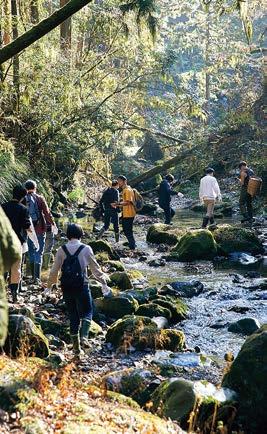
Naturally grown wasabi is rare, requiring the perfect climate and conditions to thrive – unlike the common imitation made from European horseradish. One such Goldilocks zone is hidden among the mountains and valleys of Okutama, where over 100 wasabi paddies flourish in the cool temperatures and damp shade, nourished by fresh spring water.
For an up-close look at this prized plant, book a tour with Tokyo Wasabi. As you walk through the serene forests of rural Tokyo, you’ll gain insight into traditional wasabi cultivation.
Farmers will guide you on a trek through nature to their self-built creekside farm, where you can harvest and taste fresh wasabi straight from the ground. Tours start from ¥16,500 per person (boot rentals included), with discounts for local residents. Wasabi picking is available year-round, unless you happen to visit just when all the plants are still growing. n à 1-192-4, Mitake, Ome (Mitake Station). okutamawasabi.com/wasabi_tour_en. May-Sep 8.30am-10.30am; Oct-Apr 11am-1pm, closed on some weekends and hols.
Experience some of Tokyo’s – and the world’s – most celebrated restaurants, led by today’s top chefs. By Kaila Imada

DISTINGUISHED
CALVERT heads up Sézanne in the Four Seasons Hotel Tokyo at Marunouchi, crafting dynamic French cuisine in an elegant space envisioned by architect and interior designer André Fu. The view from Sézanne adds to the experience, with large windows looking out onto the train tracks going in and out of Tokyo Station, the skyscrapers of Marunouchi glittering in the background. Calvert came to Tokyo from Hong Kong, where he was head chef at the Michelinstarred Belon.
TOKYO IS WIDELY REGARDED AS ONE OF THE WORLD’S GREATEST FOOD CITIES –and for good reason. Not only does it boast the highest number of Michelin-starred restaurants globally, but it also serves as a culinary melting pot where some of today’s most innovative chefs showcase their distinctive and imaginative interpretations of cuisines from around the world.
If you’re looking to dine at some of Tokyo’s most sought-after restaurants, be prepared: Planning ahead is essential to securing a reservation at these acclaimed spots. From flawlessly crafted pizzas to boundary-pushing Peruvian cuisine, here are the international restaurants to experience in Tokyo right now.

Sézanne earned its first Michelin star just six months after opening in July 2021, and once you sample Calvert’s technique-driven cuisine, you’ll know why. The restaurant has continued its meteoric rise, earning two Michelin stars in both 2023 and 2024, and was awarded the coveted third star in 2025 –cementing its status as one of Tokyo’s most exceptional dining destinations.
The omakase lunch and dinner menus are inspired by seasonal ingredients sourced from producers from across Japan, so no two visits are ever the same. We love the Hokkaido oysters paired with koshihikari rice and wild sorrel. All visits, however, should start with the Sézanne sourdough, made with red miso mixed with malt barley, plus a homemade starter developed by Calvert.
à Pacific Century Place 7F, 1-11-1 Marunouchi, Chiyoda (Tokyo Station). 03 5222 5810. sezanne.tokyo. Wed-Sat 12noon-1.30pm, 6pm-8pm, Sun 12noon-1.30pm (Jul-Aug), 6pm-8pm, closed Mon & Tue.
JULY
CHEF VIRGILIO MARTÍNEZ of the acclaimed Central in Lima opened his first restaurant in Japan. Maz is led by Central’s former creative chief Santiago Fernandez and channels the spirit of Central while celebrating Japan’s rich natural bounty.
Like its Peruvian counterpart, Maz’s tasting menu is structured around altitudes –beginning at sea level and ascending into the Andes. The journey opens with an ode to the ocean, where meticulously crafted seafood dishes pay tribute to the maritime cultures of both Japan and Peru.
As the menu climbs, it ventures into the Andean highlands, showcasing the biodiversity of the region. In the ‘Fresh Water’ course, grilled catfish is paired with



yacón, a tuber grown in Peru, and dragon fruit – an unexpected yet harmonious combination. At ‘Extreme Altitude’, diners are transported 4,200 metres above sea level, where aged and delicately smoked wagyu beef is paired with huacatay, an herb native to Peru. Potatoes, sourced from the cool heights of Nagano, are prepared using techniques honed in the highlands of the South American country, highlighting a thoughtful exchange between cultures. The meal descends with dessert, culminating in the ‘750-metre’ course – a tropical blend of rare Peruvian fruits that draws inspiration from the Amazon rainforest.
à Tokyo Garden Terrace 3F, 1-3 Kioicho, Chiyoda (Nagatacho Station). 03 6272 8513. maztokyo.jp. 5pm-11pm, closed Tue.
The Pizza Bar on 38th HELMED BY EXECUTIVE CHEF DANIELE
CASON, The Pizza Bar on 38th was named the Asia-Pacific region’s best pizzeria for the third consecutive year in the 2025 50 Top Pizza rankings. Last year, the

restaurant was also named one of the world’s 50 best pizzerias, coming in as the top Tokyo restaurant at No 3.
You’ll find the pizzeria inside the Mandarin Oriental, Tokyo, but it’s not your average hotel restaurant. With just eight counter seats, you’re guaranteed to get a front-row view of the pizza-making action. Pizzas are served fresh from the brick oven with simple, traditional toppings like buffalo mozzarella, tomato and basil.
Cason’s pizza dough is particularly noteworthy, made with organic Italian flour and just one gram of yeast. The dough then goes through a 48-hour fermentation period to help create the lightest, most delectable crust. The restaurant’s omakase includes an appetiser, eight different slices of pizza and a dessert. The pizzas included in the omakase change seasonally, but you can look forward to classics such as marinara topped with simple tomato sauce and the Pizzino, which includes mascarpone, olives and truffle essence.
à Mandarin Oriental Tokyo 38F, 2-1-1 Nihonbashi-Muromachi, Chuo (Mitsukoshimae Station). 03 3270 8188. mandarinoriental.com/ en/tokyo/nihonbashi/dine/the-pizza-bar-on-38th. 11am-1pm, 1.30pm-3pm, 5.30pm-7.30pm, 8pm-10pm daily.
FINE DINING IN TOKYO HAS TAKEN A SWEET TURN, with speciality restaurants now serving exquisite dessert-focused omakase meals. One standout is this charming, self-named restaurant run by acclaimed pastry chef Haruka Murooka. Opened in April 2024, the elegant space offers just six counter seats, all facing an open kitchen where you can watch Chef Murooka craft her desserts using fresh fruits and vegetables sourced directly from producers across Japan.
In just over a year, Murooka’s dessert omakase has been turning heads – earning a spot in the Michelin Guide Tokyo 2025 as a Selected Restaurant in the Creative category. It’s one of the few speciality restaurants dedicated solely to fruit- and dessertfocused cuisine.
Each dessert that Murooka turns out is a work of art, honouring her 16 years of experience in the kitchen. Her sweet multicourse meals comprise nine beautifully crafted desserts featuring the best produce of the season. For instance, this summer’s special highlights seasonal fruits like mango and melon. Though dessert-focused, her offering is punctuated with savoury elements, adding unexpected twists throughout the experience. The set courses include your choice of an alcoholic or nonalcoholic beverage pairing, featuring wines, fruit brandies, and original fruit cocktails curated by Murooka. To bring a taste of the restaurant home, cakes and other baked goods, including Murooka’s famous focaccia, can also be ordered online. n
à Luxe Minamiaoyama 1F-B, 1-21-9 Minami-Aoyama, Minato (Nogizaka Station). harukamurooka.jp. Mon & Fri 3pm, 6.30pm, Sat, Sun & hols 12noon, 3.30pm, 7pm, closed Tue-Thu.
The best exhibitions to see in Tokyo this year. By Sébastien Raineri

STUDIO GHIBLI’S IMMERSIVE SCULPTURE SHOW is back in Tokyo to captivate a new generation of fans. Featuring 3D recreations of iconic scenes from hit animated films such as Spirited Away, My Neighbor Totoro, Howl’s Moving Castle and Porco Rosso, the show is a new and improved version of the venerated studio’s first-ever art exhibition, held in the capital back in 2003.
This version features mock-ups of scenes including Chihiro’s first crossing over the bridge into the bathhouse in Spirited Away, and the thrilling segment from Ponyo where the titular character rides the waves to catch up to Sosuke in the storm. But the main draw is arguably the true-to-size replica of Porco’s Savoia S-21 seaplane from Porco Rosso
When hunger strikes, head over to T-Lotus M, a waterfront event space adjacent to the exhibition venue, for some ham ramen inspired by a similar dish in Ponyo. à Warehouse Terrada B&C Hall, May 27-Sep 23. 2-1-3 Higashi-Shinagawa, Shinagawa. 050 5541 8600. 9.30am-8pm daily (last entry 7pm).
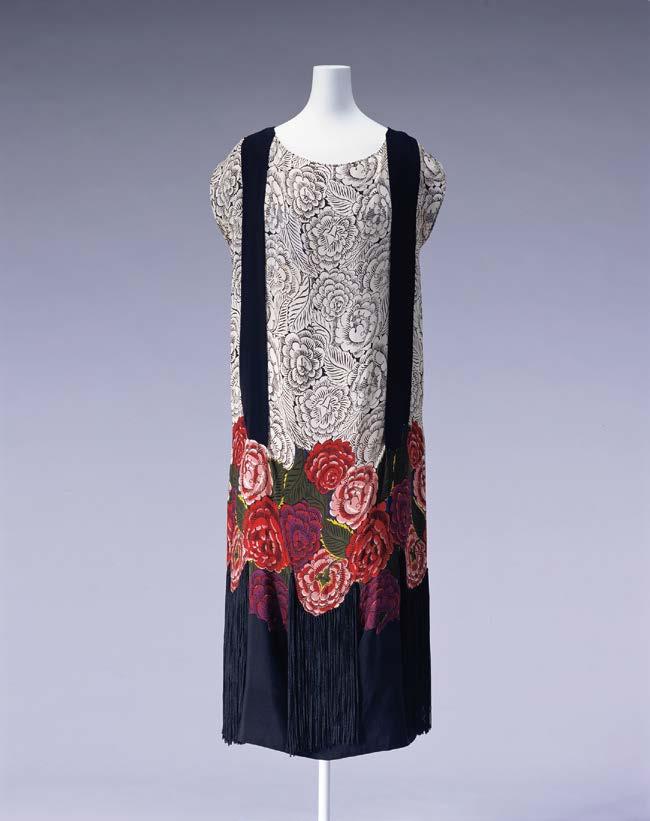
Art Deco and Fashion: Centering on the Kyoto Costume Institute Collection
WOMEN’S EMANCIPATION WAS IN FULL SWING at the beginning of the 20th century and had a considerable influence on fashion. The interwar period saw the emergence of more liberated women, in search of a modern and daring style reflecting their new spirit. At the same time, the Art Deco movement was born, blooming during the 1920s in architecture, fashion and furniture.
Art Deco fashion came to be characterised by geometric and clean shapes, bold colours and high-quality materials. Beaded dresses, furs, feathers and sequins make up the Art Deco wardrobe, where graphic patterns and bold prints bring a touch of sophistication and theatricality to outfits. Looking back at this era of luxurious and opulent wear – and celebrating the centenary of the 1925 International Exhibition of Modern Decorative and Industrial Arts in Paris – the Mitsubishi Ichigokan Museum is organising the ‘Art Deco and Fashion’ exhibition from October 11 2025 to January 25 2026. The museum will display about 60 iconic Art Deco outfits – including evening dresses from the great Parisian houses such as Poiret, Chanel and Lanvin – as well as paintings, prints, handicrafts, and other artwork from Japanese and overseas museums.
à Mitsubishi Ichigokan Museum, Tokyo, Oct 11-Jan 25. 2-6-2 Marunouchi, Chiyoda. 050 5541 8600. 10am-6pm (until 8pm on Fridays, 2nd Wed of the month, and weekdays on the last week of the exhibition), closed Mon (open hols), Dec 31 & Jan 1.

Aki
KANAGAWA-BORN, NYCBASED AKI SASAMOTO ’s decompartmentalised artistic practice explores performance, sculpture, dance and any other medium conducive to the expression of her ideas. At the intersection of visual and performing arts, her work involves collaborating with musicians, choreographers, scientists and academics, and she often takes on multiple roles, be it a performer, curator or sculptor.
This exhibition explores the interplay between sculptural creation and performance that has characterised the artist’s work for two decades. From landmark early examples to more recent creations that emphasise kinetic elements, it offers a comprehensive overview of Sasamoto’s journey and approach, where the boundaries between artistic disciplines blur to create a captivating hybrid experience.
à Museum of Contemporary Art Tokyo, Aug 23-Nov 24. 4-1-1 Miyoshi, Koto. 03 5245 4111. 10am-6pm (Fridays in Aug & Sep until 9pm), closed Mon (open hols, then closed following day).
The Architecture of Sou Fujimoto: Primordial Future Forest IN THE SPOTLIGHT due to his role as the designer of the Expo 2025 site, Sou Fujimoto is an architect whose work explores the relationship between nature and buildings. Born in Hokkaido in 1971, he is inspired by the natural landscapes of his childhood and seeks to integrate organic forms into the urban environment through an approach he calls ‘primitive future’. This philosophy translates into an exploration of the meeting points between indoor and outdoor spaces, and the natural and the artificial.
Fujimoto’s first major Tokyo retrospective offers a comprehensive overview of the

architect’s journey over the past quarter century. Scale models, plans and photographs sit alongside larger installations, providing an immersive experience of the essence of his work. The exhibition highlights projects including the Musashino Art University Museum & Library, L’Arbre Blanc (The White Tree) in Montpellier, France, the House of Music in Budapest, and – of course – the Expo site on Osaka’s Yumeshima.
à Mori Art Museum, Jul 2-Nov 9. Mori Tower 53F, 6-10-1 Roppongi, Minato. 050 5541 8600. 10am-10pm (Tue until 5pm).

A Renewal of Passion: The Impact of Van Gogh
THOUGH HE DIED AT JUST 37, Vincent van Gogh left behind a body of work that revolutionised modern art; an oeuvre celebrated for its swirling brushstrokes, bold colours and raw emotional force. Yet the Dutch master’s legacy is shaped as much by his turbulent life as by his luminous canvases.
The Pola Museum of Art’s first-ever exhibition dedicated to Van Gogh features key works from the museum’s own collection alongside historical and contemporary responses to his art, highlighting how the post-Impressionist painter has inspired generations of artists across continents and eras.
The show emphasises Van Gogh’s influence in Japan, where his deeply personal style resonated as early as the Meiji era (1868–1912), and highlights modern reinterpretations by artists such as Yasumasa Morimura and Fiona Tan. Composed of paintings,
installations and archival materials, the exhibition offers a poignant meditation on the enduring power of Van Gogh’s vision.
à Pola Museum of Art, May 31-Nov 30. 1285 Sengokuhara, Hakone, Kanagawa. 0460 84 2111. 9am-5pm daily.
Bvlgari Kaleidos: Colors, Cultures and Crafts CLASSICAL ELEGANCE AND MEDITERRANEAN HERITAGE meet daring innovation in the artisanal jewellery of Bulgari, the Rome-based luxury house that’s become synonymous with exceptional craftsmanship over its 140-year history.
This show, the brand’s largest in Japan and its first in a decade, offers an opulent journey through nearly 350 pieces of jewellery and contemporary art. Its name a portmanteau of the Greek words kalos (beautiful) and eidos (form), the show presents a kaleidoscopic narrative where colour is both the medium and the message. It showcases Bulgari’s use of hues as a hallmark of its innovation, from the postwar ‘chromatic revolution’ in gemstones to the vibrant combinations that define the brand’s legacy today.
Divided into three thematic chapters, the exhibition explores colour through scientific,

cultural and sensory lenses. Contemporary artists Mariko Mori, Lara Favaretto and Akiko Nakayama offer personal meditations on the theme, while scenography by architect Kazuyo Sejima and design studio Formafantasma unites Roman grandeur with Japanese minimalism.
à The National Art Center, Tokyo, Sep 17-Dec 15. 7-22-2 Roppongi, Minato. 050 5541 8600. 10am-6pm (Fri, Sat until 8pm), closed Tue (except Sep 23) & Sep 24.

TSUKASA HOJO’S ACTIONCOMEDY manga City Hunter debuted in Weekly Shonen Jump in 1985 and has since become firmly established in the Japanese comics canon. The story follows the charismatic and talented private investigator Ryo Saeba, an inveterate womaniser, as he takes on high-stakes missions in Tokyo together with his partner Kaori Makimura, helping those in need while wreaking havoc in the criminal underworld.
Held to commemorate the serialised manga’s 40th anniversary, this special showcase features a vast collection of original artwork, tracing the series’ evolution over four decades. Fans will have the opportunity to immerse themselves in the world of City Hunter through rare illustrations, behind-the-scenes sketches and recreations of iconic moments that have defined the series. n à Ueno Royal Museum, Nov 22-Dec 28. 1-2 Ueno Koen, Taito. 03 3833 4191. Times TBA.
Stock up on quality wardrobe staples – think timeless T-shirts, durable denim, classic glasses and more. By Kaila Imada

IN AN ERA OF FAST FASHION AND FLEETING TRENDS, classic pieces like a well-fitting pair of jeans, a crisp white tee and clean, minimalist sneakers offer enduring style and versatility throughout the seasons.
If you’re looking to invest in essential pieces that truly last, Tokyo has got you covered. Renowned for craftsmanship and attention to detail, many Japanese brands with boutiques in the capital specialise in creating highquality, elevated basics that not only stand the test of time, but often improve with wear. Here are some of our favourites.
Junky Special in Shinjuku is one of the few physical stores in Tokyo where you can pick up Whitesville tees. The brand is produced by Toyo Enterprise, a long-established Japanese manufacturer that has been producing T-shirts, sweatshirts and other fashion items domestically in Japan since 1965.
These high-quality T-shirts are crafted from finely woven cotton with a high stitch count and feature a durable ribbed neckline, ensuring long-lasting wear and excellent shape retention. The classic twopack T-shirts come in white, black, navy and grey. They’ve become a hot commodity over the last couple years thanks to hit American TV series
The Bear, where protagonist Carmy is often seen sporting the brand’s classic white tee.
à ¥7,590 for a pack of two. 2-46-5 Kabukicho, Shinjuku (Shinjuku Station). 03 3232 0850. junkyspecial.com. 11am-8pm daily.
Masunaga1905 has been producing highquality eyewear in Fukui prefecture for over a century. Known for its exceptional craftsmanship and attention to detail, the brand continues to innovate while maintaining its rich heritage. At its Shimokitazawa boutique, Masunaga embraces modern technology with a cuttingedge, non-contact shopping experience – a unique and hygienic way to find your perfect pair of frames.
Here’s how it works: instead of physically trying on glasses, a specialised device equipped with nine cameras captures a 180-degree image of your face. It precisely measures the distance between your pupils and the height of your eyes to create a detailed 3D avatar. You can then virtually try on different frames, seeing how each style fits your unique features. You’ll never look at glasses shopping the same way again.
à From ¥57,200. 3-19-20 Kitazawa, Setagaya (Shimokitazawa Station). 03 6407 1905. masunaga1905.com. 11am-8pm, irregular hols.

If you’re on the hunt for a well-curated selection of vintage finds, elevated basics and chic home accessories, make a beeline for Front 11201 in trendy Yoyogi Hachiman. The shop offers a vast selection of vintage items from the 1940s to the 2000s, all sourced from the States and Europe.
Aside from vintage threads, the boutique stocks Front 11201’s very own house brand of unisex tank tops, tees, hoodies, sweats and collared shirts – all of which are made in Japan. We especially love the feel of the classic cotton sweatshirts, crafted from Front 11201’s original fabric. The material is soft with a distinctive springy texture that delivers exceptional comfort. These sweatshirts are a seasonal staple and return each season in different colours.
à ¥12,980. Createur B1F-1F, 4-5 Motoyoyogicho, Shibuya (YoyogiHachiman Station). front11201.com/en. 12noon-8.30pm, Sat 12noon-9pm, Sun 11.30am-8pm.
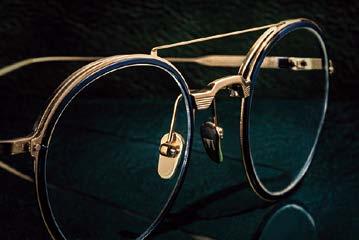
Momotaro Jeans has a fascinating origin story rooted in both the ‘birthplace’ of Japanese denim and a beloved folk tale. The brand hails from Kojima in Okayama prefecture, a city renowned for its high-quality denim craftsmanship. One of Momotaro’s signature details is the pair of white stripes often painted on the back pocket – an homage to the legendary character Momotaro, who also hailed from Okayama and who carried a flag marked with two white lines.
At the Aoyama boutique, you’ll find the brand’s full line-up of premium denim pieces including jeans, jackets and shirts. Momotaro denim is made from Zimbabwe cotton, prized for its soft feel, durability and the way it develops a unique fade over time with more and more wear. You can also find jeans made with a blend of other luxurious materials such as silk and cashmere. One standout feature of Momotaro denim is its ‘Tokuno Blue’ – a deep, rich indigo created through multiple rounds of dyeing. The brand also offers a lifetime repair warranty, ensuring your jeans are built to last.
à From ¥29,700. Ao 2F, 3-11-7 Kita-Aoyama, Minato (Omotesando Station). 03 6427 9721. momotarojeans.com. 11am-8pm daily.

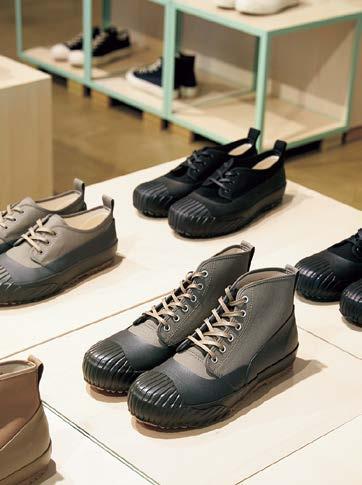
Moonstar is a heritage footwear brand based in Kurume, a city in Fukuoka prefecture known for its proud manufacturing history and unique shoemaking techniques. Since its founding in 1873, the company has been producing comfortable, made-in-Japan footwear – from classic tabi-style shoes to contemporary sneakers.
At this Jiyugaoka flagship store, you can browse the brand’s shoe selection including the popular ‘Fine Vulcanized’ collection, which features flexible, durable soles that maintain their shape over time. These timeless sneakers are available in various styles, from slip-ons and mules to low-cut lace-ups and high-top all-weather options. The latter designs are especially practical, featuring rubber sides bonded seamlessly to canvas uppers, making them ideal for yearround wear – rain or shine. n
à ¥8,800-¥19,800. 2-16-27 Jiyugaoka, Meguro (Jiyugaoka Station). 03 6421 3066. inuse.jp/moonstar_jiyugaoka. 11am-7pm, closed Tue.


‘We know Japan loves a proper performance’
The Australian band Confidence Man on moving to London, the joys of remixes and what to expect from their upcoming set at Fuji Rock. By Patrick Balfe
IT’S BEEN A HUGE YEAR for Australian electro-pop outfit Confidence Man. After releasing their third album, 3AM (La La La), in October 2024, they have toured the UK, Ireland, Canada and the US, including a DJ set at Coachella’s Do LaB stage. Now, following the release of the remix album 5 AM (La La La), they’re heading to Japan. Ahead of their appearance at Fuji Rock, we caught up with vocalists Janet Planet and Sugar Bones to hear more about what they’ve been up to and what to expect from their set.
3AM (La La La) is your first album since moving to London in May 2023. How has the move influenced your writing?
Janet Planet: Being exposed to the music culture here [in the UK] definitely shaped it. Even touring here a few years ago, I remember seeing [British electronic duo] Orbital. I was like, ‘Who are these dudes?’ That was part of the reason we wanted to move here in the first place, hanging out with all these people doing amazing stuff that doesn’t really make sense in Australia. There’s not that connection to rave culture back home.
Sugar Bones: Day-to-day life here [in London] is just so much more energised. There’s people everywhere and there’s just shit going on all the time. You can feel the energy that comes with that. Being in a big city gives you a boost, and that creeps into the music.
The remix album 5AM (La La La), which came out in mid-April, has remixes from American artists like Fcukers and Australian artists like King Gizzard & the Lizard Wizard. What influenced your choice of remix artists?
JP: The King Gizzard thing is a left-field one. We’d always been mates with those guys and seen them around, and we were kind of like, ‘They’re a bit bonkers, it would be pretty interesting to get them on a remix.’ And with the Fcukers guys, we were touring with them a lot, and we did a remix for them for [their 2024 track] ‘Bon Bon’, so it kind of made sense to do a little remix swap with them, we’re big fans.
With the rest of them, we just chose people who we love, and we wanted to see what they would do with the tracks, and the package is pretty sick. We actually had like another 20 remixes on top, so there’s a lot more where that came from.
SB: That’s a luxury to just be able to ask your dream list of producers to remix your stuff.
It’s been about five years since you were last in Japan. Is there anything that sticks out about your last visit here?
SB: Oh, we’ve just been wanting to go back the whole time. It’s just such a sick place. We fell in love with Tokyo. We were only there for a few days, but it was such a great few days. We want the food, we want the really nice people, the beautiful city. We just love everything

‘I’m really excited to see a Japanese crowd. A lot of the musicians we talk to say that the crowds are super rowdy’
about it, and we’ve been waiting to get back, so we’re so excited.
You’re coming back for Fuji Rock this July. What are you most excited to do while you’re here?
JP: I’m going to buy heaps of clothes. I mean, obviously I’m excited for Fuji Rock too [laughs]. I’m really excited to see a Japanese crowd. A lot of the musicians we talk to say that Japanese crowds are super rowdy. Last time, we were so early in our career that we probably didn’t fully experience what that crowd is like. So we’re excited to get over there and throw down.
SB: We’ve got a plan, which is to get our label management to let us film a clip over there. So we want to spend a week there, in Tokyo or nearby.
JP: We have a Japanese-inspired song, so that’s why we want to video it there. It’s one of two songs that we have for the new album.
What should people expect from your Fuji Rock set?
JP: Only the regular rowdy controlled chaos. The multiple costume changes, the laser bra, lots of spilling champagne – and a few flips.
SB: Expect the unexpected because we’re definitely gonna have to turn up the show because we know Japan loves a proper performance. We will be putting our backs into it, that’s for sure. n
à Fuji Rock is at Naeba Ski Resort, Jul 25-27. fujirockfestival.com.
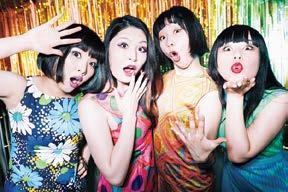
Five other acts to see at Fuji Rock Festival 2025
Saturday, July 26
Following sold-out club shows in Japan last October, Ireland’s NewDad are returning to these shores for Fuji Rock. The band caught international attention last year with their moody debut album Madra, and their reverbladen riffs and ethereal vocal melodies will make for a perfect late afternoon set.
Saturday, July 26
Night Tempo is the stage name of Jung Kyungho, a South Korean producer and DJ known for remixing Japanese city pop classics. His reworkings, including Maria Takeuchi’s ‘Plastic Love’, have helped repopularise city pop, and his passion and respect for the genre have earned him a following worldwide.
Friday, July 25
Since 2009, Kyoto-based all-woman punk quartet Otoboke Beaver has been blowing minds and eardrums with their tight, frenetic and LOUD live performances. Overseas, their appearances at events including Coachella, Glastonbury and SXSW have caught the attention of publications like Pitchfork and NPR, earning them a reputation as one of Japan’s most exciting live acts.
Friday, July 25
South Africa-born singer-songwriter Ecca Vandal hasn’t slowed down since releasing her debut single, ‘White Flag’, in 2014. Over the past 11 years, her power and aggression have remained constant throughout her experimentation with different genres, and her biting vocals effortlessly cut through heavy layers of punk, hip-hop and electronica.
Saturday, July 26
The king of city pop will be making his firstever performance at Fuji Rock this year. The 71-year-old is headlining the Green Stage on Saturday night, and we’re anticipating hits like ‘Ride on Time’, ‘Sparkle’ and ‘Silent Screamer’.
Get to know some of Tokyo’s hottest go-go boys.
By Christopher House
AH, GO-GO BOYS. What’s not to love? These professional dancers elevate the energy of any event where they perform, LGBTQ+-related or otherwise. From freestyle dancing and choreographed routines to the infamous ‘towel show’ – dancing completely in the buff holding nothing but a small towel to cover their bits – go-go boys (almost) bare it all for our entertainment.
But who are these Adonises when they aren’t shaking their stuff on stage? Get to know these scientists, mathematicians, dog lovers and mama’s boys as we profile some of the city’s best performers. Follow them on social media for more info on where to find their upcoming shows, and remember to bring a tip to show your appreciation.


WITH A PASSION FOR COOKING and a Master’s in mathematics to accompany his modelling gigs and three-year go-go career, Japanese-American dreamboat Sai is the whole package – his 25.7k followers on Instagram would likely agree.
Sai initially started performing out of curiosity, but the Alabama boy soon found his popularity soaring as he achieved a level of fame he hadn’t anticipated. Now he performs practically every week, whether in Japan or abroad.
When it comes his work, Sai says courtesy towards the dancers is key. ‘Though there’s a sexual element to what we do, at the end of the day we’re still human beings worthy of respect.’ Amen to that.
àFollow Sai on Instagram @saimansaystkyjp

HAILING FROM EDOGAWA, go-go veteran Taiga has been lighting up stages all over Japan since 2014 and has no intentions of stopping anytime soon. You’ll find him mainly at Eagle Tokyo Blue, where he also works as a server. The versatile performer likes to combine masculine and feminine elements into his routines – must be his Gemini energy. Taiga hopes he will inspire other performers who may feel constrained to dancing only in a masculine way to showcase more fluidity in their expression. When he’s not on the stage, you’ll still find him dancing along to anything with a good beat, working out, going on walks or playing with his toy poodle, Polo.
àFollow Taiga on Instagram @taichangram._
‘Though there’s a sexual element to what we do, at the end of the day we’re still human beings worthy of respect’
IRISH BOYO Dío is relatively new in town –the environmental toxicologist slash personal trainer with a penchant for potato bread started performing in 2022 in Seoul and made his Tokyo debut the following year.
Despite being a relative newbie, the gyrating ginger’s moves are red hot (pun intended). He likes to keep things sensual and sexy on stage, especially when performing together with his partner Gio, who’s also a go-go boy. For Dío’s solo shows, be prepared to see him tumbling, cartwheeling into splits or doing any number of high-energy stunts during his routine.
You’ll catch Dío performing every few weeks at Kingdom Tokyo (likely in fetish wear), but don’t expect him to stay in one place too long – Dío loves to travel. ‘I always need to have a vacation booked,’ he jokes. ‘Or I’ll go crazy!’
àFollow Dío on Instagram @dio.xclusiv
SAY HOLA TO SHIGERU GIBO. Born and raised in Lima, the 45-year-old Peruvian came to Tokyo back in 2000 to work at a sushi restaurant after finishing culinary school. He stayed in Tokyo for three years, then bounced around Latin America before eventually returning to Japan in 2015.
Now he’s juggling many hats as the manager of both Eagle Tokyo Blue and Eagle Osaka in addition to doing go-go part-time in both cities. Given his Peruvian roots, Shigeru likes to add a little Latin flair to his performances, but don’t let the machismo fool you. He’s a softie at heart who credits his mother as his biggest inspiration in life.
àFollow Shigeru on Instagram @shigerutokyo
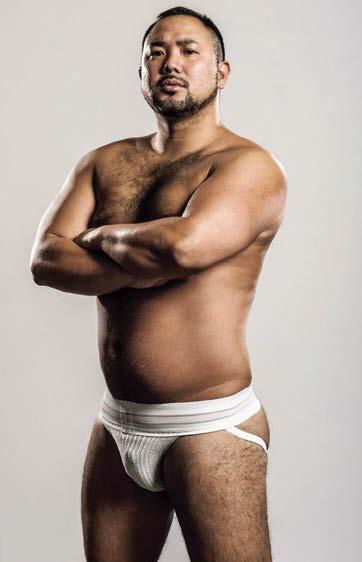

Yuta
BY NIGHT, Chiba native Yuta Kuroda is ‘Rico’, a go-go boy extraordinaire who’s been performing all over Japan and abroad since 2018. By day? He’s a consultant for a global recruitment firm and has experience working with multi-million-dollar companies. Did we mention he’s a finalist for Mr Gay Japan 2025?
An avid lover of fitness and staying active, Yuta enjoys tennis, volleyball and weight training in his free time. He’s currently preparing for a bodybuilding competition in August, but when he’s in the mood for a treat, you’ll find him chowing down on his favourite dish: Japanese curry. n
àFollow Yuta on Instagram @gori_yuta_rico

Kingdom Tokyo is Shinjuku Nichome’s first kink-themed bar. Get your fill of pole dancing, go-go boys, drag queens and fetish wear at the venue’s many themed nights and exclusive events.
àTOM Bldg 1F, 2-10-7 Shinjuku, Shinjuku (Shinjuku-Sanchome Station). 03 6380 0072. kingtokyo.jp/kingdom. Sun-Thu 6pm-3am, Fri & Sat 6pm-5am.
Eagle Tokyo Blue is one of the largest gay bars in Japan. Beefy bears abound, but everyone is welcome at the neon-blue venue. From go-go dancers and drag shows to DJs and karaoke nights, this place is a must for a night out in the neighbourhood. àCasa Verde B1F, 2-11-2 Shinjuku, Shinjuku (Shinjuku-Sanchome Station). 03 6876 8450. eagletokyo.com. Mon-Thu 8pm-4am, Fri-Sun 6pm-4am.

Whether you want to stay in the bright lights of Tokyo or are keen to visit Osaka in its Expo year, the New Otani has a hotel you will love.
The New Otani chain has provided hospitality and luxury to guests since September 1964, when its Tokyo flagship hotel opened on the eve of the Olympic Games. More than 60 years later, Hotel New Otani Tokyo continues to set the standard for top-quality accommodation in the capital, while in this landmark Expo year, its Osaka hotel offers comfort and convenience for visitors to the Kansai metropolis. Here are five things you’ll love about the New Otani hotels in Tokyo and Osaka.
The breakfast
Hotel New Otani Tokyo excels when it comes to the most important meal of the day. There are several options: authentic Japanese breakfasts at Kioi Nadaman; a buffet with a view on the 40th floor of the Garden Tower; or American or continental breakfasts alongside
the splendid Japanese greenery at the Garden Lounge. But for a breakfast feast so renowned that people travel from great distances just to try it, Satsuki is the place. For Japanese food lovers its extensive breakfast buffet offers freshlymade onigiri, shoyu ramen with minced pork, ikura (salmon roe) and a vast array of sushi and tsukemono (pickles). There’s also bone-in Iberian ham, French pastries from Pierre Hermé Paris and a yoghurt bar with superfood toppings.
The 10-acre landscape gardens at Hotel New Otani Tokyo predate the rest of the complex by approximately 400 years. Once owned by samurai lords, this pocket of tranquillity at the heart of the world’s biggest city features a traditional stone garden with rare red stones from the coast of Niigata prefecture, the scarletcoloured Taikobashi Bridge over a koi pond, and a gorgeous pool area complete with a restaurant
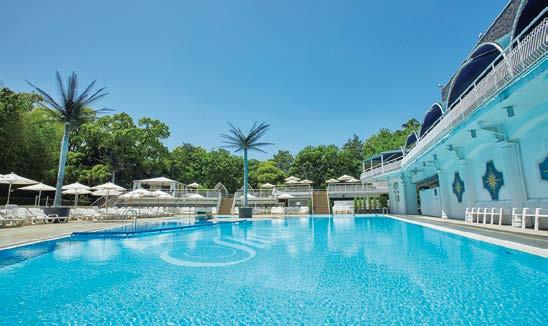

serving gourmet burgers and fruity cocktails. The garden pool is open until September and available to hotel guests at no additional cost (blackout dates may apply).
It can sometimes feel like Hotel New Otani Tokyo is a long way from the bustling metropolis, but its peaceful location is in fact in the heart of the city. There are several metro stations within walking distance, giving visitors access to many of Tokyo’s subway lines, and plenty to visit nearby including the Toyokawa Inari Shinto shrine, the National Diet Building and the Imperial Palace.
One of the most indulgent culinary experiences in the capital can be found on the 17th floor of the main building. Panoramic views of the city accompany a sumptuous buffet with live cooking stations creating
Western, Japanese and Chinese dishes – the sushi and tempura stations and the wagyu beef at the teppanyaki are highlights.
Executive House Zen is a hotel within a hotel – a luxury boutique offering, inspired by Japanese traditions of hospitality, which is guaranteed to make any Tokyo stay extra special. The experience begins with exclusive check-in at the Zen Lounge, where complimentary drinks and light meals – not to mention a glorious view of the city skyline, the Akasaka Palace and Mount Fuji – are available from morning to night (chocolates and macarons from Pierre Hermé Paris make the perfect end-of-day treat). The emphasis on comfort, luxury and personalised service extends to the spacious, beautifully appointed guest rooms, some of which come equipped with cypress wood


in tempura, oden and sake (Isshin); soba and udon (Nakajima), sukiyaki and hotpot (Fujio), yakiniku barbecue (Jojoen Yugentei) and Edo-style sushi (Kenzan). The pick of the bunch, however, is Keyaki, a teppanyaki restaurant on the top floor where skilled chefs flip meat and fish on the grill to a stunning backdrop of Osaka Castle and the city skyline.
Executive chef Shinsuke Nakajima’s bread and pastries at Patisserie Satsuki deserve their own mention. Among the gorgeously crafted items on sale at this alluring lobby-level store are Mont Blanc chestnut cakes, strawberry mille-feuilles, mamekan (a traditional Japanese dessert made with sweet red beans and agar cubes) and Japanese-style shortcakes with colourful layers of fresh fruit and fluffy sponge.
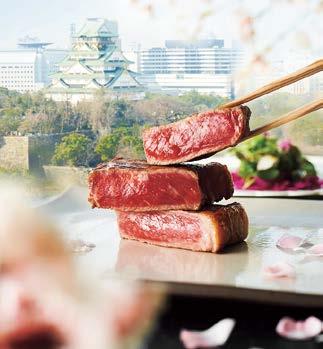
bathtubs for the full Japanese bath culture experience.
à Hotel New Otani Tokyo. 4-1 Kioicho, Chiyoda, Tokyo. 03 3265 1111. newotani.co.jp/en/tokyo.
As is the case in Tokyo, Hotel New Otani Osaka is located in a bubble of tranquillity at the heart of the city.
On the banks of the Daini Neya river, a short walk from the 16th-century Osaka Castle, the hotel is ideally located for the city’s most popular tourist attractions, including Universal Studios Japan.
There are more than a dozen restaurants, bars and cafés at Hotel New Otani Osaka, including upscale French eatery Sakura, elegant Chinese venue Taikan En, and Japanese places specialising
The rooms at Hotel New Otani Osaka, just like those in Tokyo, put an emphasis on comfort. From the superior rooms with their views of Osaka Castle to the extra spacious deluxe rooms, the accommodation is always elegant, tastefully furnished and very comfortable. A series of fabulously renovated new family rooms with space for up to seven guests call on ancient Japanese style, with delicate screens, beautiful hinoki baths and a suite of welcome amenities including locally made sake.
The most anticipated event in Japan is taking place in Osaka this year – and it’s super-easy to get from Hotel New Otani Osaka to the Expo 2025 site. The journey on the Osaka Metro Chuo Line from Morinomiya Station, close to Hotel New Otani Osaka, to the newly built Yumeshima Station, at the entrance to the Expo site, is simple, direct and takes around 40 minutes. à Hotel New Otani Osaka. 1-4-1 Shiromi, Chuo, Osaka. 06 6941 1111. newotani.co.jp/en/osaka. n
Five reasons you should be in Japan’s second city this summer
By Marcus Webb
On the shores of Osaka Bay, a once-empty artificial island has been transformed into a vision of the future. Yumeshima, the site of Expo 2025, is in the middle of hosting a six-month global gathering where innovation meets imagination. Visitors can wander through the Grand Ring – a vast wooden structure that encircles the site – explore more than three dozen immersive pavilions, and witness cutting-edge tech like flying cars and AI-driven experiences.
Japan’s own contributions are deeply rooted in sustainability and wellbeing, while nightly light shows and interactive installations ensure there’s wonder at every turn. Even the food is forwardthinking, with experimental menus and eco-conscious dining. All this and Myaku-Myaku, the Expo’s surreal, waterinspired, five-eyed mascot who’s fast become a local icon.


Osaka’s neighbourhoods are also forwardthinking, adaptable and open to change. Take Nakazakicho, an unassuming district tucked behind Osaka Station. Until not long ago it was largely abandoned and semi-derelict, but today it’s Osaka’s hipster hub, with cafés, restaurants, galleries and boutiques lining its winding lanes. Salon de Amanto, the art café that sparked Nakazakicho’s revival, turned a dilapidated 19th-century building into a lively community space, and other small businesses followed suit.
It’s a similar story in Kitakagaya, where artists and creatives have turned factories and warehouses into studios and galleries, bringing life to an industrial area that struggled after the decline of the local shipbuilding industry. Umekita, meanwhile, used to be largely disused railway sheds until it was transformed by the ambitious Grand Green project.

A local love of new ideas, bold flavours and culinary experimentation – and a determined shunning of airs and graces – makes Osaka the perfect location for the first Time Out Market in Asia. Here the most exciting food in the city can be enjoyed in a welcoming space, including as a takeaway enjoyed in the park on its doorstep. For elevated takes on Osaka classics you can try new-wave kushikatsu at Kushiage001 produced by Kushiage010, and fresh takes on okonomiyaki and takoyaki at Koala Shokudo. For the full lineup see tinyurl.com/TOMOsaka

SHINKANSEN
The easiest way of getting to Osaka from Tokyo is via bullet train. The trip takes two and a half hours on the Tokaido Shinkansen, with trains departing from Tokyo Station to Shin-Osaka Station. Tickets start from ¥13,620.
OVERNIGHT BUS
Time rich but cash poor? Several companies run overnight buses between Tokyo and Osaka. The journey takes around eight hours and tickets start from ¥1,700.
PLANE
Flights are available from Haneda or Narita airports to Osaka’s two airports, Itami (which is around 30 minutes to central Osaka by taxi, bus or train) and Kansai International (50 minutes to central Osaka by express train or airport bus). The journey usually takes between 70 and 90 minutes with tickets starting at ¥4,890.
W Osaka is a playful and unabashedly stylish option located on Midosuji Boulevard – the city’s answer to the Champs-Élysées – while New Otani Osaka offers a classic luxury hotel experience on the banks of the Daini Neya river, a short walk from the 16th-century Osaka Castle.
Tipplers are spoilt for choice in Osaka, where the options for sipping an exquisite cocktail are always growing, and run from the quirky to the sophisticated. At the wonderful Bible Club, hidden away down a secret staircase in Namba, they’ve taken the Prohibition-era theming extremely seriously, with antique glasses, furniture and decorations, even going so far as to source a US flag with 48 stars.

Those who move on elsewhere are well advised to turn their steps towards Bar Nayuta, just a short saunter away. Even more challenging to locate, up several flights of stairs in an otherwise anonymous block, Nayuta repays the effort to visit many times over. This pocket-sized venue is lit by candles and dominated by a gleaming, well-stocked bar staffed by skilled mixologists. There are no menus here – the charming barkeep will give you a brief interview about your flavour preferences before creating a completely new cocktail designed just for you.

With its silver screen-themed rides and attractions, Universal has been thrilling kids and adults since 2001. But things stepped up a notch with the opening of Donkey Kong at the tail end of 2024. An addition to the already ace Super Nintendo World, the new zone includes games, rides, food kiosks dishing out DK-themed snacks, and Donkey Kong’s house, where you can meet the titular gorilla in person.
The standout attraction is Mine Cart Madness, a fast-paced rollercoaster that recreates the rail-jumping action of the games, launching riders from barrels and sending them hurtling over broken tracks. You really do feel like your cart is leaving the safety of the rail, which will have you laughing or screaming, depending on your disposition. n
…the streets at night become a playground for fortune-tellers, buskers and stranded travellers
By Shota Nagao
TOKYO TEEMS WITH SIGHTS AND SOUNDS ALL NIGHT LONG.
That’s especially true in nightlife hotspots like Shibuya, Shinjuku, Roppongi and Ginza, where in between late-night restaurant- and bar-hopping adventures you’ll come across a host of intriguing characters, from station-side buskers to psychics to salarymen who had one too many and chose to use a roadside bush as a makeshift bed. Here’s what to expect on a night out in the capital.
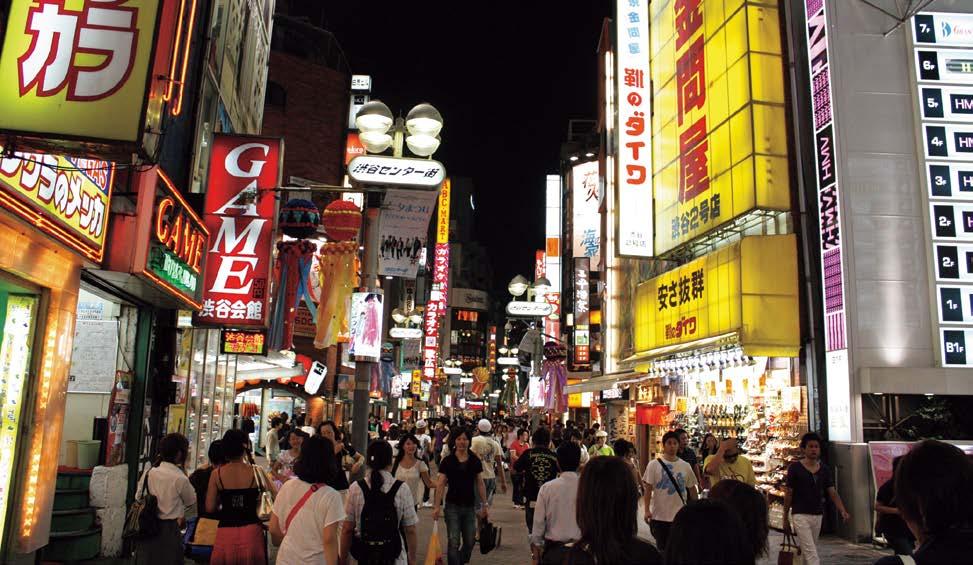
Fortune-tellers
Squatting in tiny seats, their booths marked by lanterns with the words ‘destiny’ or ‘palm reading’ in kanji characters ( ), fortune tellers are a common nocturnal sight. You’ll spot them gazing into the future along Bunkamura-dori near the Mega Don Quijote or in front of Shinjuku Station’s west exit. Why not pop in and ask where the night might take you next?
Shibuya meltdown
First-time visitors to Tokyo may understandably find it concerning to stumble upon tired revellers lying on the ground in Shibuya as though unconscious. But these sleeping beauties aren’t waiting for a prince to rescue them. Rather, they’re participating in the semi-cultural phenomenon known as the ‘Shibuya meltdown’, in which
partiers who’ve had one too many simply snooze it off in the street. These tipsy dozers are arguably a testament to how safe this city is.
Convenience storefront drinkers
Although public drinking around stations including Shibuya and Shinjuku has declined since a 2024 crackdown, the ubiquitous convenience store is still for many the go-to spot for grabbing a quick chu-hi (canned shochu cocktail) before a night out at the clubs. That said, as your trusted guide to the city’s best bars and restaurants, we’d always nudge you in the direction of supporting local establishments instead.
Missed-last-train wanderers
Tokyoites heading out for the night always plan for the fact that trains end their service at around 12.30am and only
resume at about 4.30am. For the unfortunate souls who are left stranded after the station gates close, the options narrow down to walking or grabbing a cab home – or wandering around the city in search of a capsule hotel or 24-hour restaurant.
Shinjuku street buskers
Tokyo isn’t exactly known for being busker-friendly, with regular police crackdowns keeping street performances short-lived. Your best chance of catching several musicians in one spot is along the Koshu Kaido avenue by Shinjuku Station’s south exit. Guitarists and keyboard players often line the sidewalk, spacing themselves out with customary consideration to avoid overlapping soundscapes. Just don’t expect the show to last too long – the authorities tend to move them along fairly quickly. n

